Chester Fields 2020: Global Warning
While closed, The Polygon will be curating weekly programming online. We hope this provides inspiration during these difficult times and reaffirms that the voice of artists, now more than ever, is a vital one. Follow us on Instagram as we’ll be sharing the images from each exhibition there before anywhere else.
Follow The Polygon on Instagram
We find ourselves in the unprecedented circumstances of a global pandemic. As we stay in our homes, cut off from travel, shopping, and the everyday conveniences we are used to, there is an opportunity to reflect on aspects of consumerism we seldom consider: long supply chains demanding needless jet fuel; excess products sitting in warehouses that never needed to be manufactured, most of which will end up as toxic waste; an economy modelled on endless growth, which is neither sustainable nor even realistic. We have a chance to pause, and seriously rethink how we live.
The theme of this year’s Chester Fields Teen Photography Program was Global Warning, inviting artists to visualise the forces of nature—and the forces that threaten it. What emerges in the 2020 finalists’ works is a sense of creativity, courage, and clarity as they capture dynamic circumstances and far-reaching consequences affecting our Planet Earth. Through their images, these 38 artists anticipate a precarious future, celebrate the fight against climate change, and hold the decision-makers of today and yesterday to account. This year’s artists have done much more than meet the Chester Fields challenge: they have posed a challenge of their own, one that everyone must urgently meet, especially as today’s new “global warning” forces all of humanity to embrace uncertain futures and profound change.
A special thanks to our jurors: artist Marian Penner Bancroft, Capture Photography Festival Assistant Curator Cheyenne Rain Legrande, and photographer and National Geographic Explorer Amy Romer. My gratitude to the teachers across the Lower Mainland and beyond who extended this opportunity to their students. To the nearly 300 artists who submitted work to this year’s competition: thank you for your honest and remarkable vision. Congratulations to our finalists. – Justin Ramsey, Assistant Curator
Image: Annalise MacCallum, The New Nature (detail).
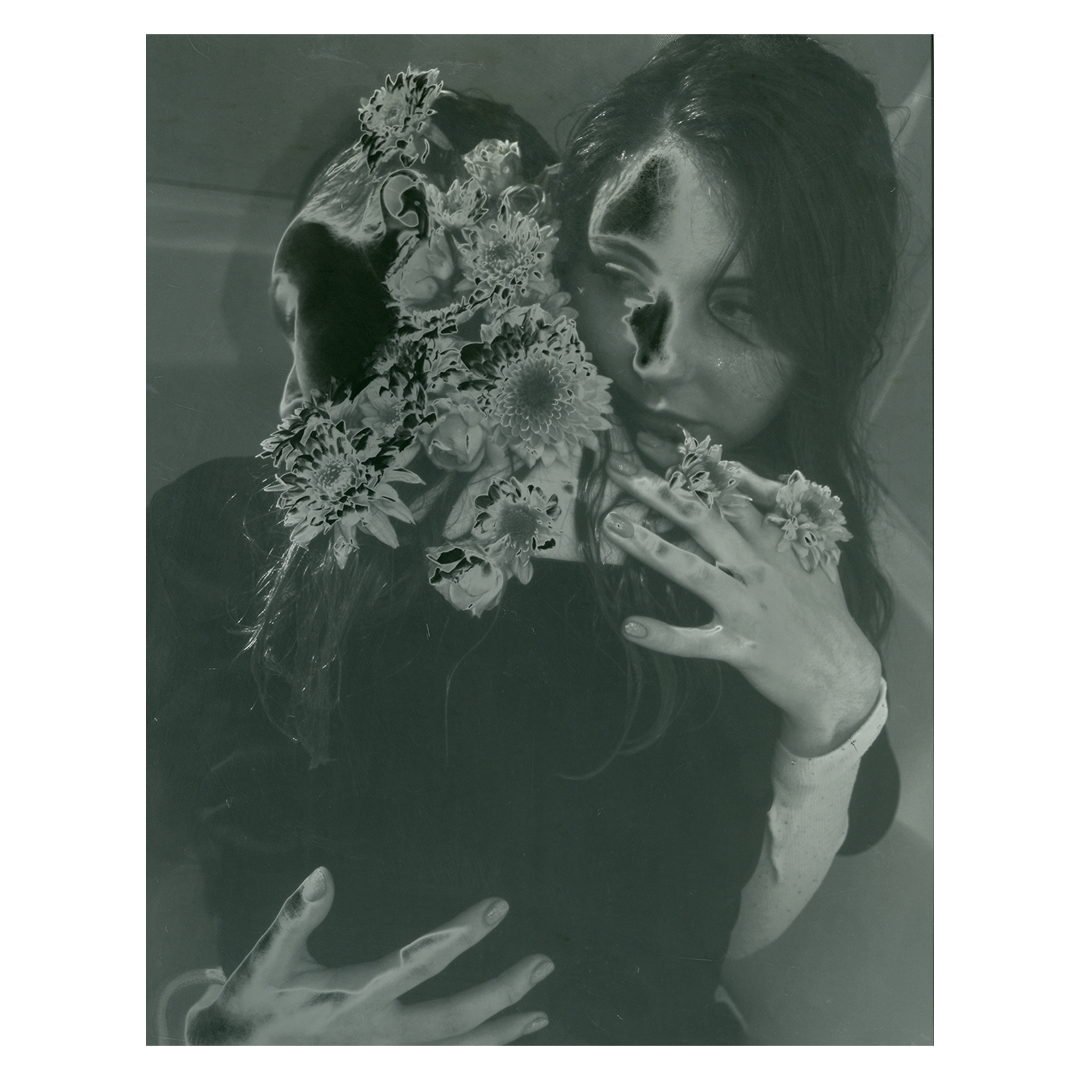
Sally Sapinski
Untitled
My intention for this image was to represent the symbiotic connection between the Earth and the people of today. The Earth is within all of our lives, and as its flowers die, we slowly go with them. I created this image by solarising a digital negative.
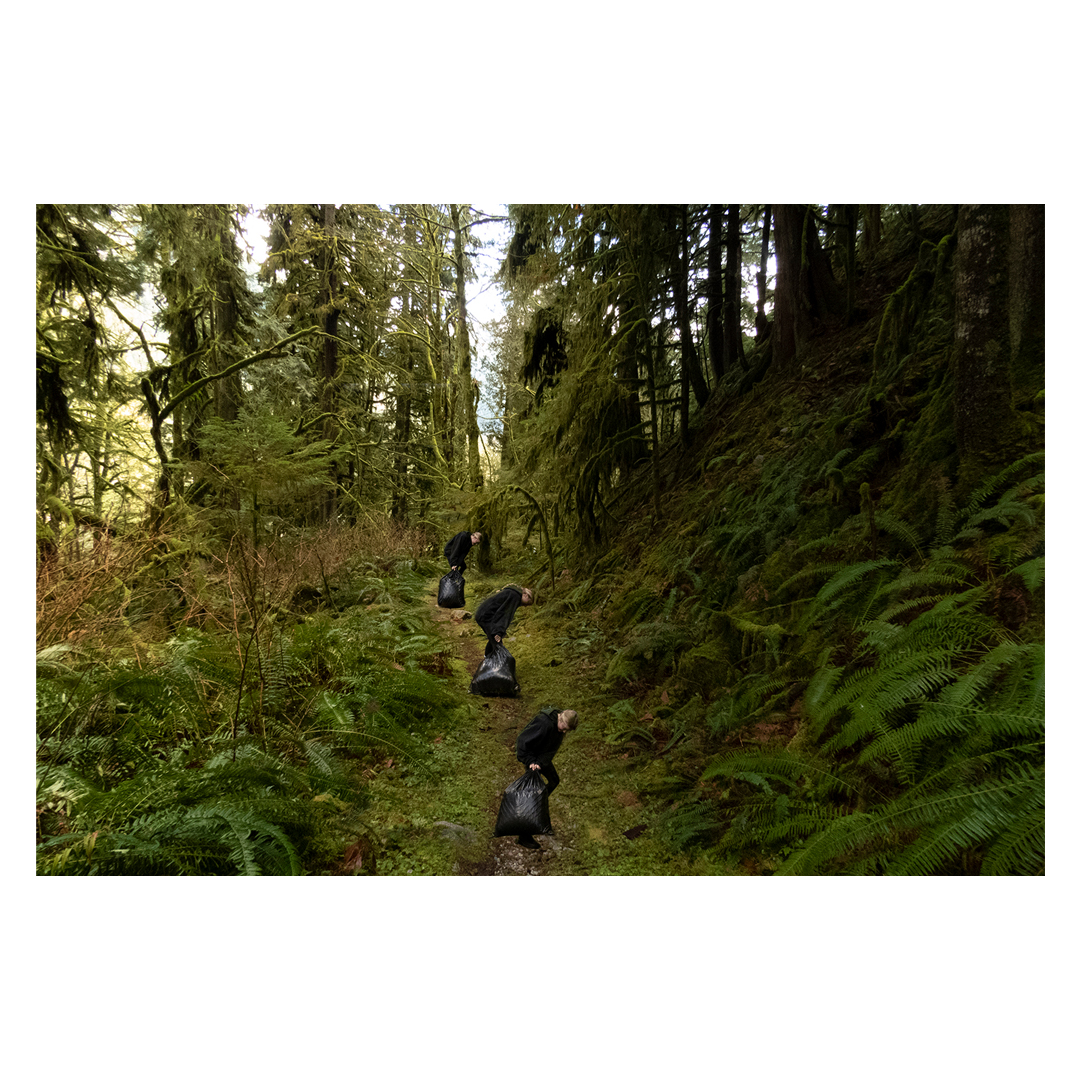
Emma Renshaw
Our Wasteful Ways
In Our Wasteful Ways, I captured an image of a girl being weighed down by trash to symbolise how pollution is negatively impacting our daily lives and our environment. The girl is featured multiple times to emphasise the process of climbing the trail as the trash is getting heavier with every step. This photograph brings awareness to the detrimental effect of our continuous wasteful ways and habitats we destroy in the process.
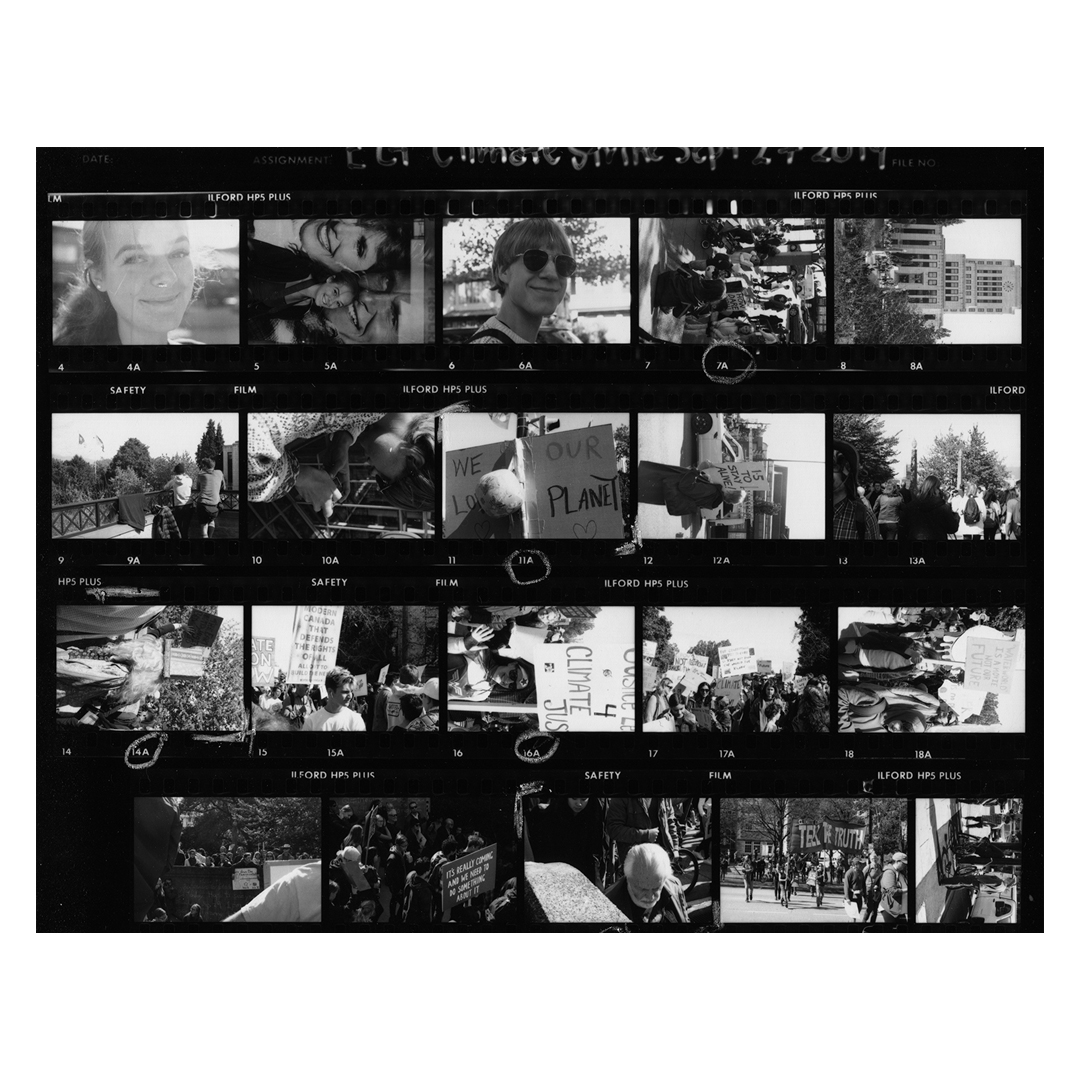
Emma Gibb
Untitled
The most effective form of social change is protest. When I pondered the topic of “Global Warning”, I immediately thought of the incredibly powerful protests that have been happening in not only Vancouver, but globally. Recently, youth around the world have been rallying around their local parliaments to generate action from their governments surrounding climate change. In support, I attended several of these youth protests in 2019 that drew in thousands of teens and young adults from around the Lower Mainland. The youth climate strikes have been extremely empowering, and show what’s really important for younger generations. Our voices are stronger and louder than ever before.
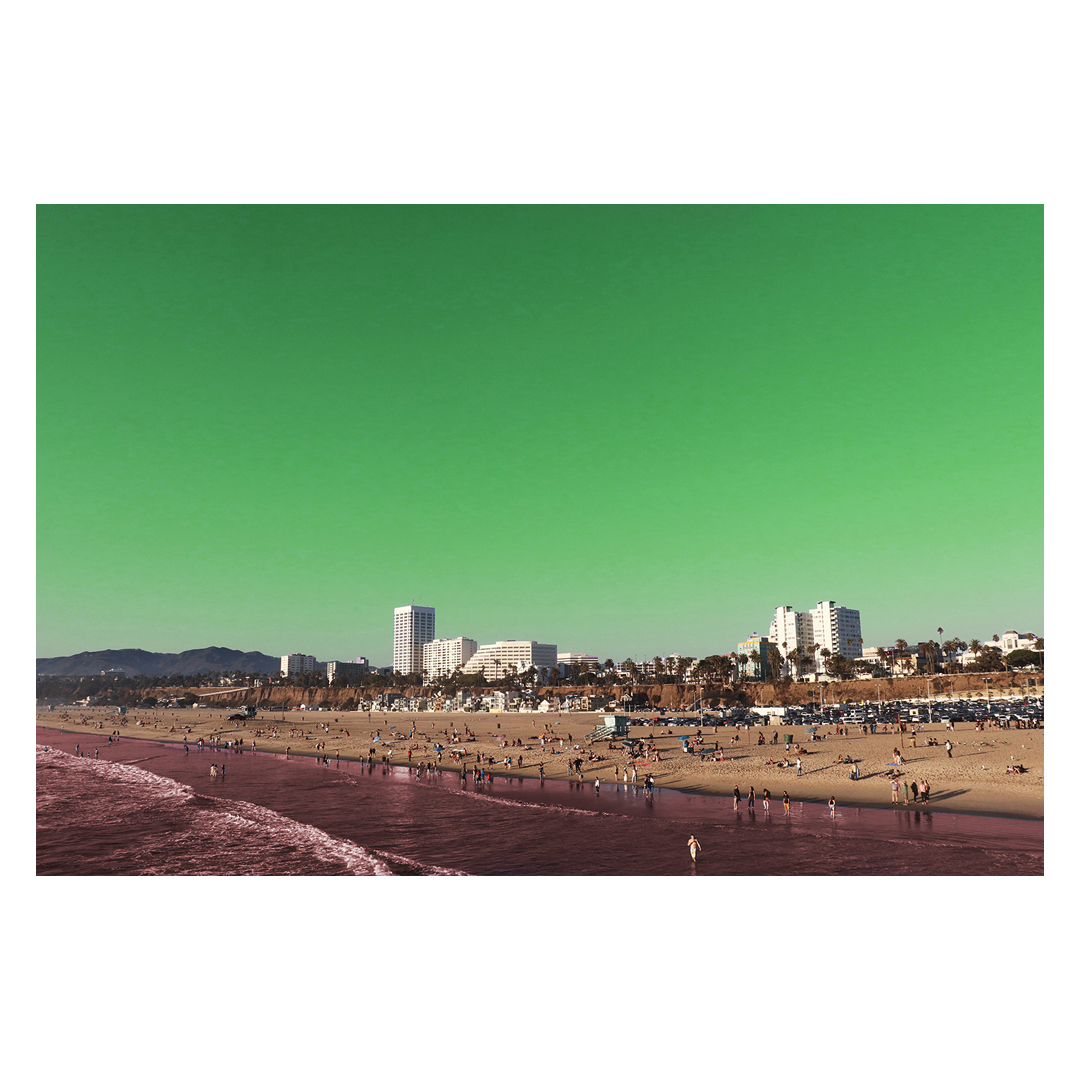
Simon Burns
SoCal 2050
I used a shot I had taken from the Santa Monica pier while on vacation there. I turned the sky a sickly green and the ocean blood red to represent an extreme version of our future. However, I left the people in the shot unedited to represent our society’s indifference towards these issues.
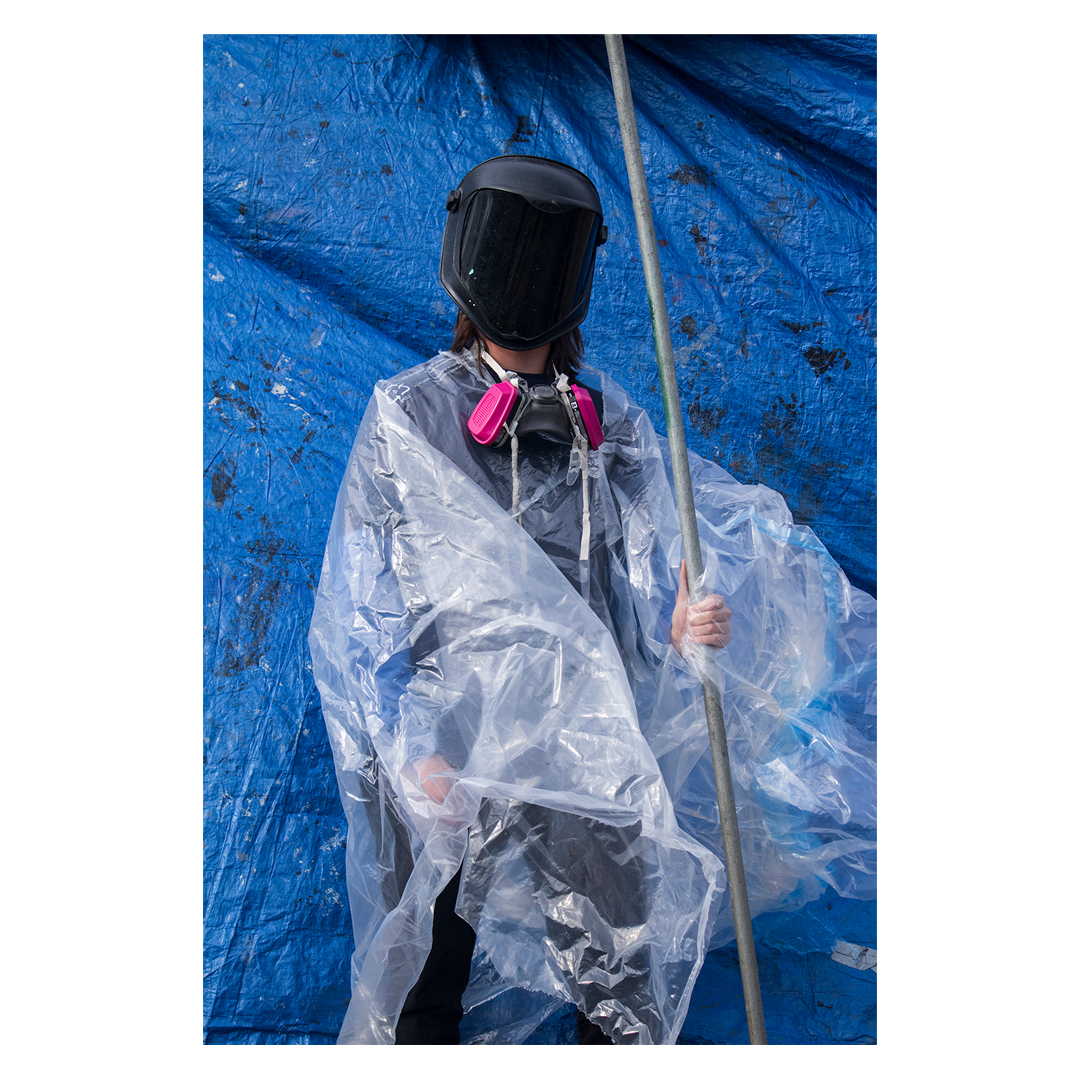
Desi De Koninck
Untitled
Using multiple symbols on the model, I am showing the viewer my view about climate change and the future of our planet. The air filter represents the diminishing air quality in our environment due to our carbon footprint, and the welding mask represents the effects of UV-rays from the lacking ozone layer.
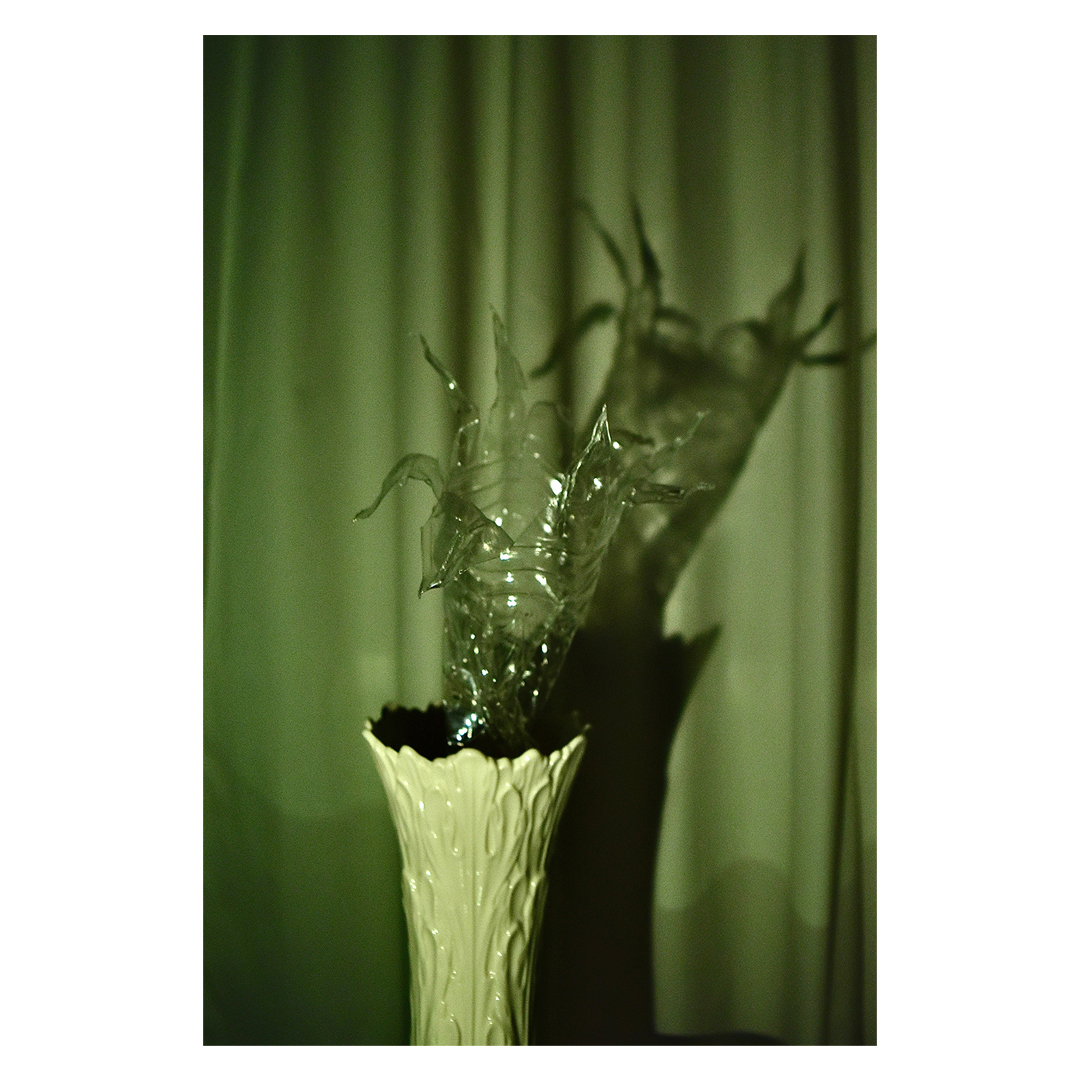
Ella Goldman
Untitled
Plastic is one of the most detrimental materials to our planet in terms of littering. Despite its level of negative impacts on our planet, it can still be portrayed quite beautifully. I decided to play on plastic’s level of false beauty, by putting it in place of something natural—a flower. This shows how easy it is to disguise something quite terrible for our planet as something of beauty.
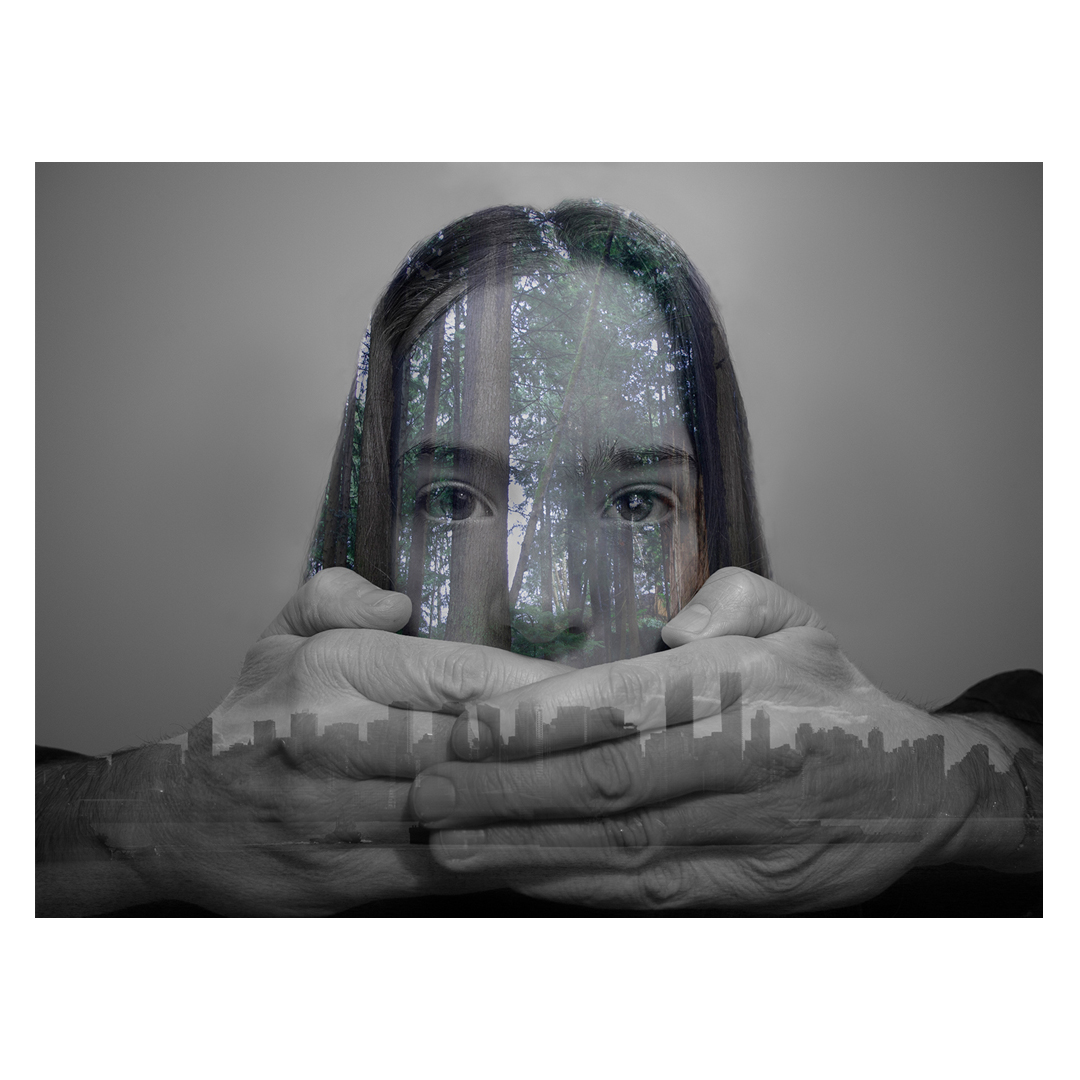
Talia Facey
Her Last Breath
I captured an image of a young girl with hands clasped over her mouth to represent how industrialisation is suffocating nature. Through the use of double exposure photography, I have combined an image of the city into hands to represent their dominance over natural landscapes. In contrast, the image of the forest is fading into the background to show how it is being overpowered by humans and urban culture.
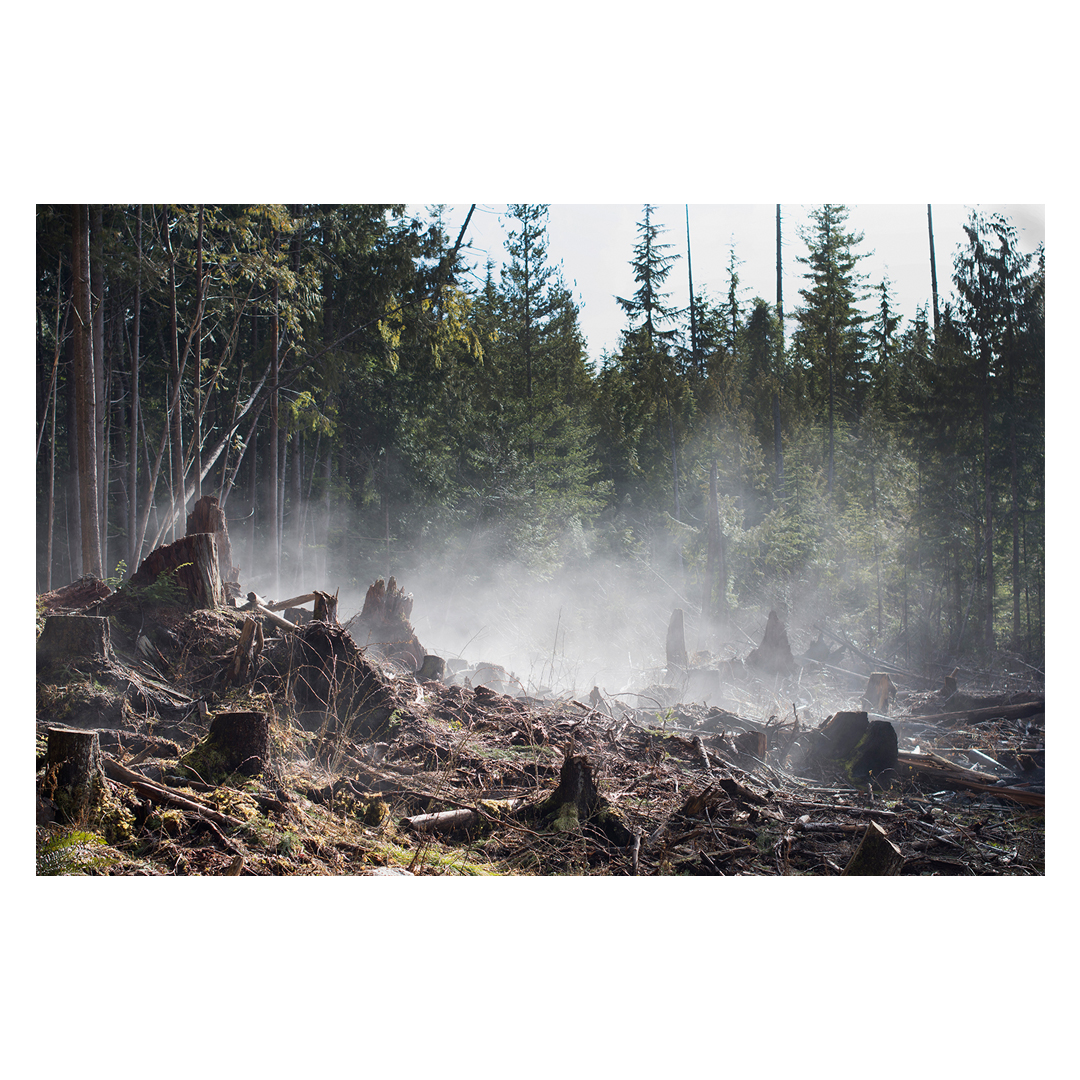
Nora Trépanier
Untitled
My first thought when I heard the theme, Global Warning, was of deforestation. It plays a big part in global warming and I feel that it is sometimes overlooked. This photo was taken on a family trip to the Sunshine Coast. It is a tradition to do this hike and the last time we went it was a gorgeous, lush forest. This year, we stumbled upon this clearing where all the trees used to be. It made all this talk about global warming feel so much more real. Things are changing and not for the better. Seeing the lack of trees broke my heart. I want my photo to warn people about deforestation.
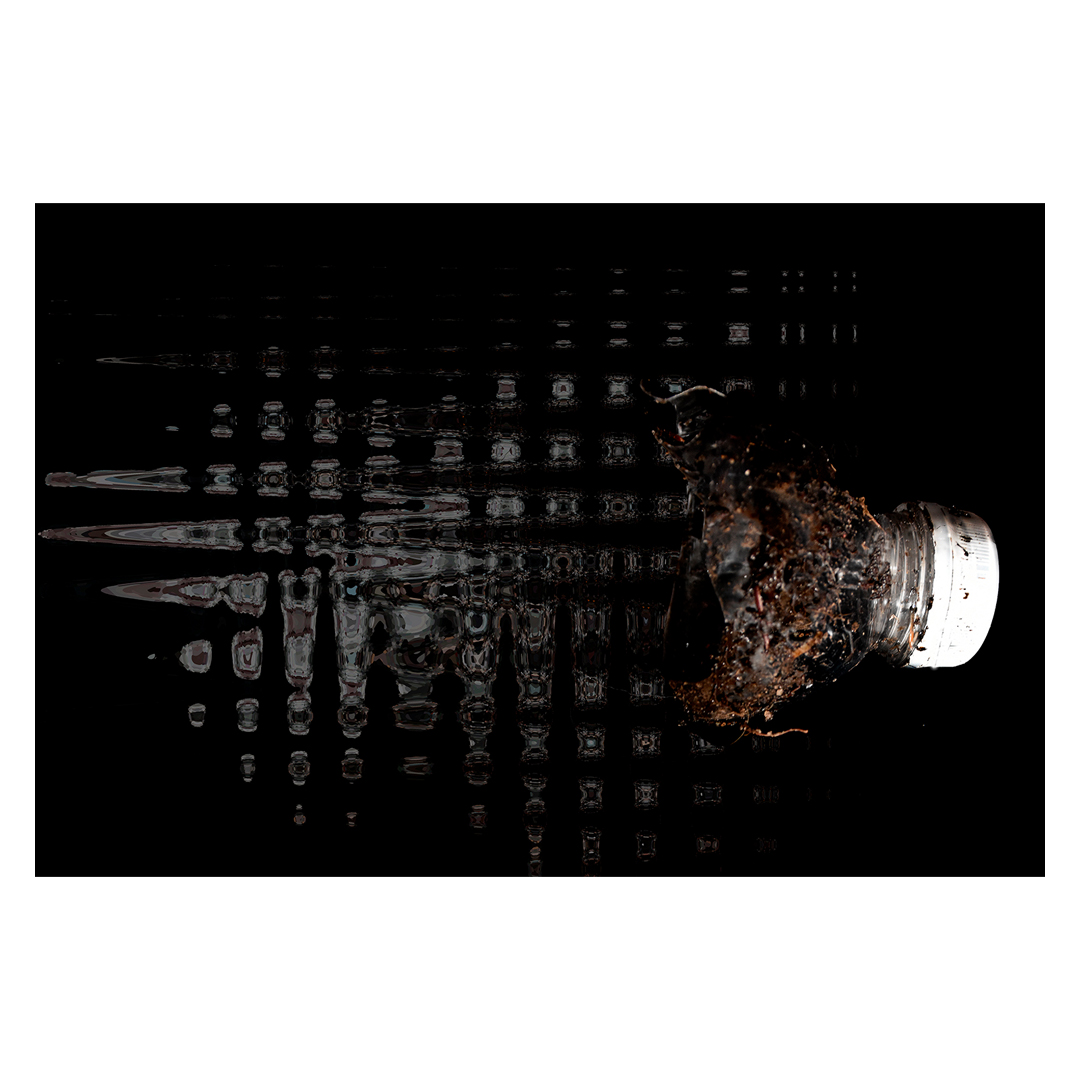
David Lisle and Sam Peets
Botal uisge feargach
The title, Botal uisge feargach, in Scottish Gaelic means “Angry water bottle”. I am an athlete, and I drink Gatorade, so I am angered by seeing fellow athletes disrespecting the Earth. Plastic is overwhelming nature and the Earth is mad, because we are hurting it to such a great extent! The image is a water bottle that has been edited to show the lengthy decomposition of plastic bottles, and their effect on nature.
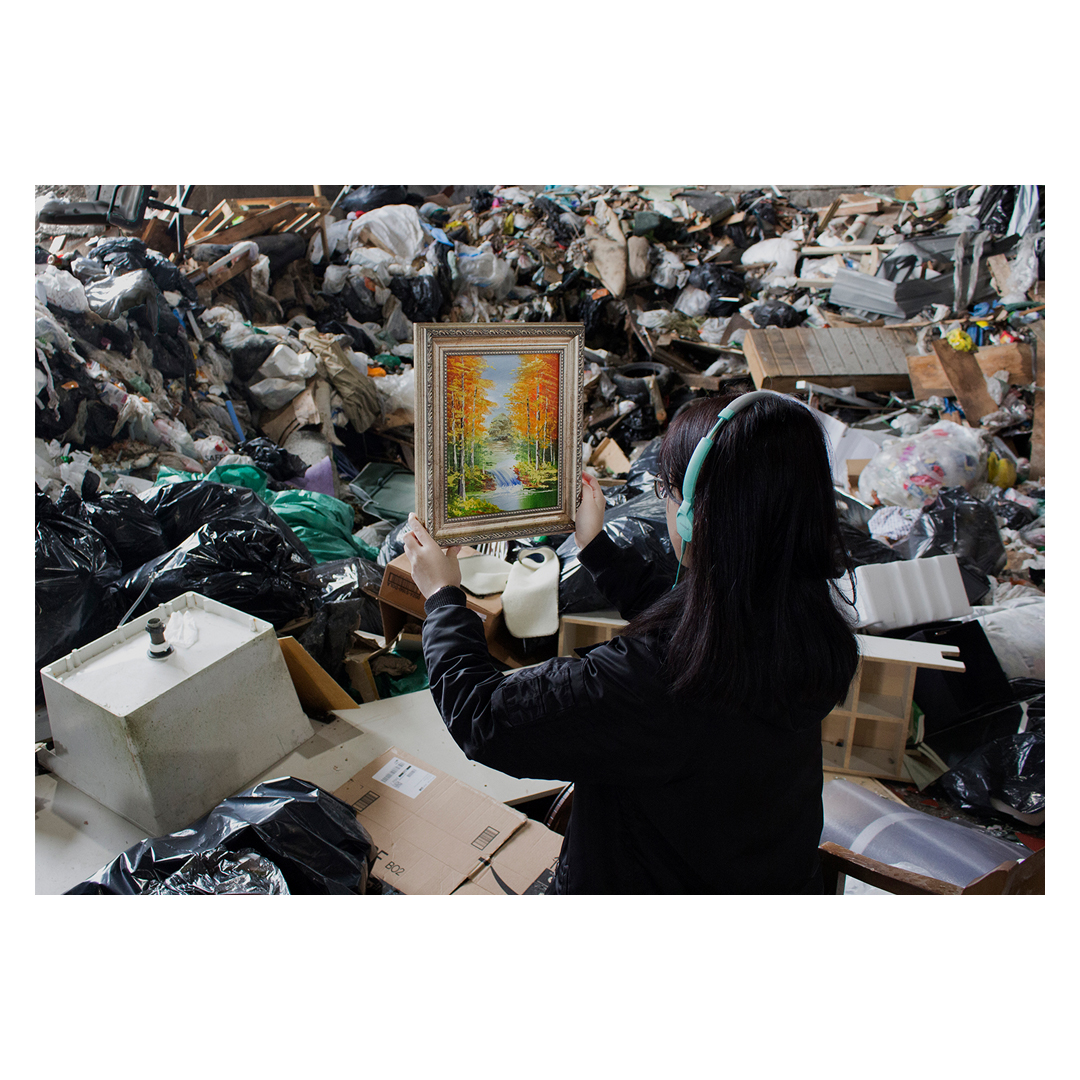
Dorothy Dong
Picture perfect
To mask their reality, people sometimes will make up beliefs or distinct explanations that paint a prettier image for them to live off of. I think it is never easy to face the scary and overwhelming reality but that does not justify hiding from it. Even politicians and famous world leaders force these lies into people’s minds and create a group of people that don’t do anything to solve the problem because they don’t accept it. The person in the picture is surrounded in garbage; however, she is oblivious to it and only focuses on the pretty image she is holding in front of her. The painting depicts a fictional world where she doesn’t have to worry about the pressing problems around her. She’s wearing headphones and blocking out her surroundings, but the picture won’t cover her forever.
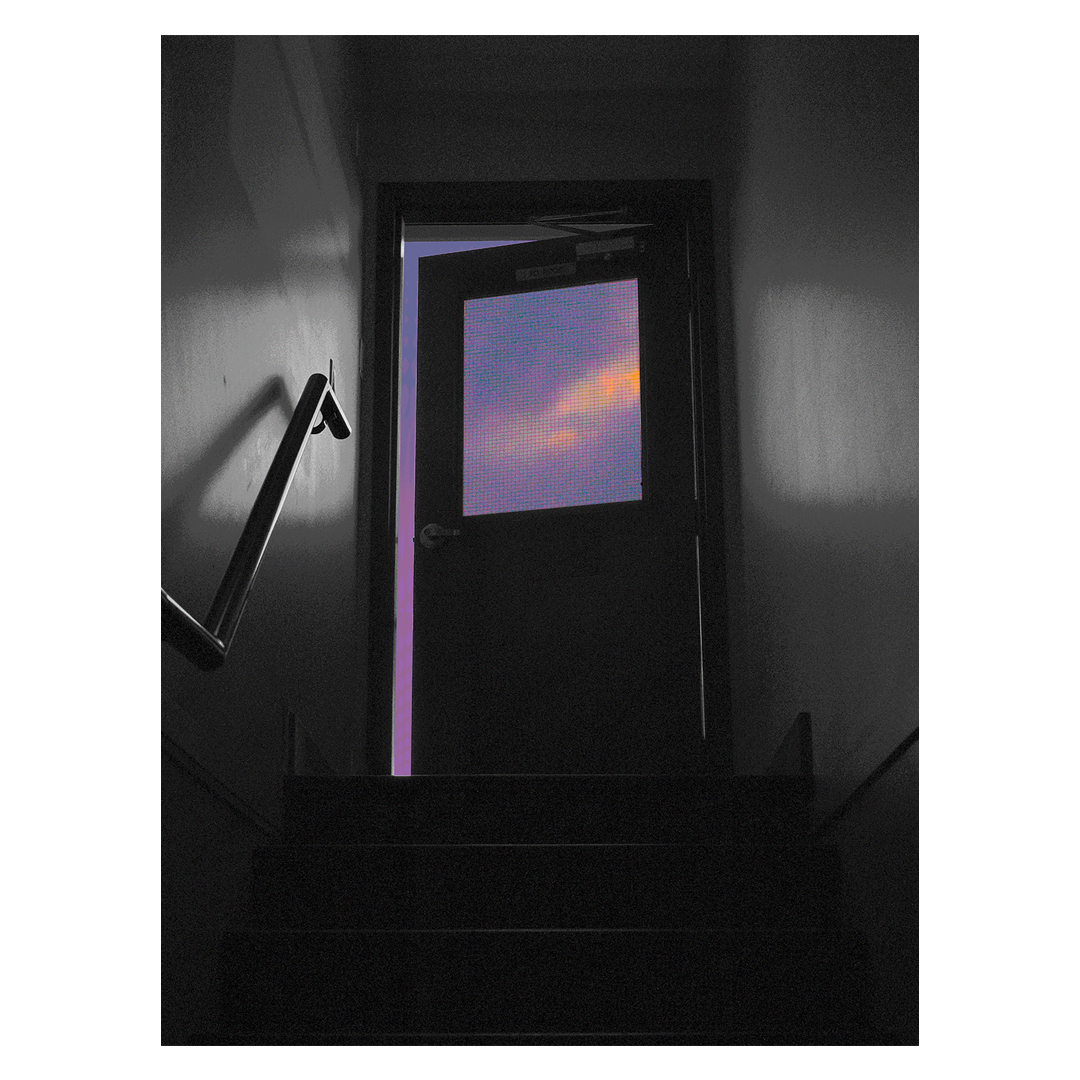
Morris Ling
Stairwell to the sky
In the 21st century, we have the privilege of updates on the latest news always at our fingertips. This has become an important aspect of our lives, one that many have come to think of as essential. However, due to the mass spread of the information age, we have become desensitised to the persisting issues regarding our natural surroundings. In my photo, Stairwell to the Sky, I attempted to capture the inactive attitude of modern society and what we can do to change. The desaturation of the interior symbolises our societal negativity perpetuated by media outlets and news sources. The stairwell setting represents ascending to higher ground and being “enlightened” by what the natural world has to offer. The door parallels our mobile devices; instead of being in awe behind a glass frame, you must take action in order to truly experience nature.
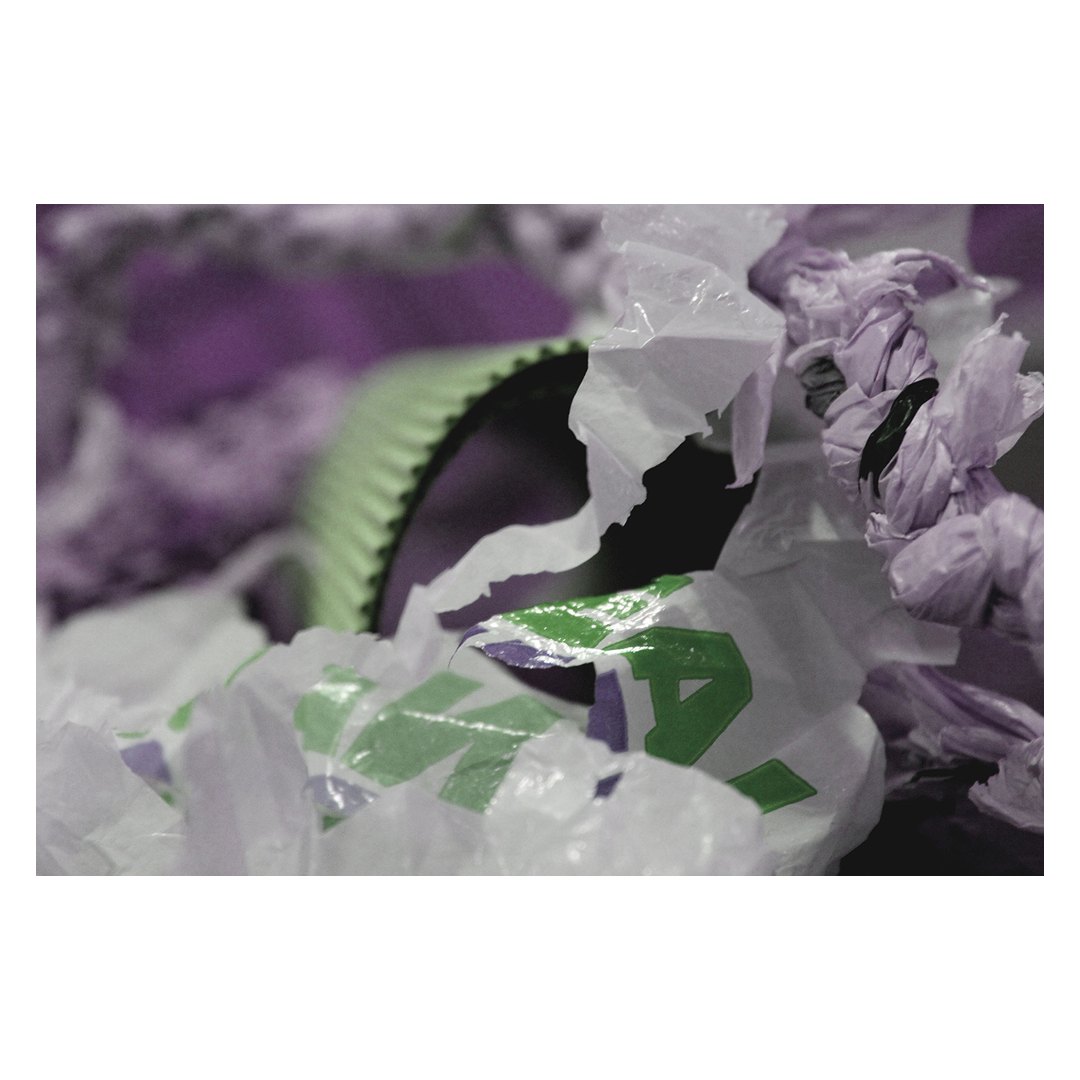
Mia Cornish
Trasharama
Trasharama shows how much trash is in the world. I used cardboard and plastic bags because I wanted to make a photo sculpture. I used hues and levels to make the photo look purple and green. You see less green around because there is less rain from global warming. The material inspired me, and art-making calms me down.
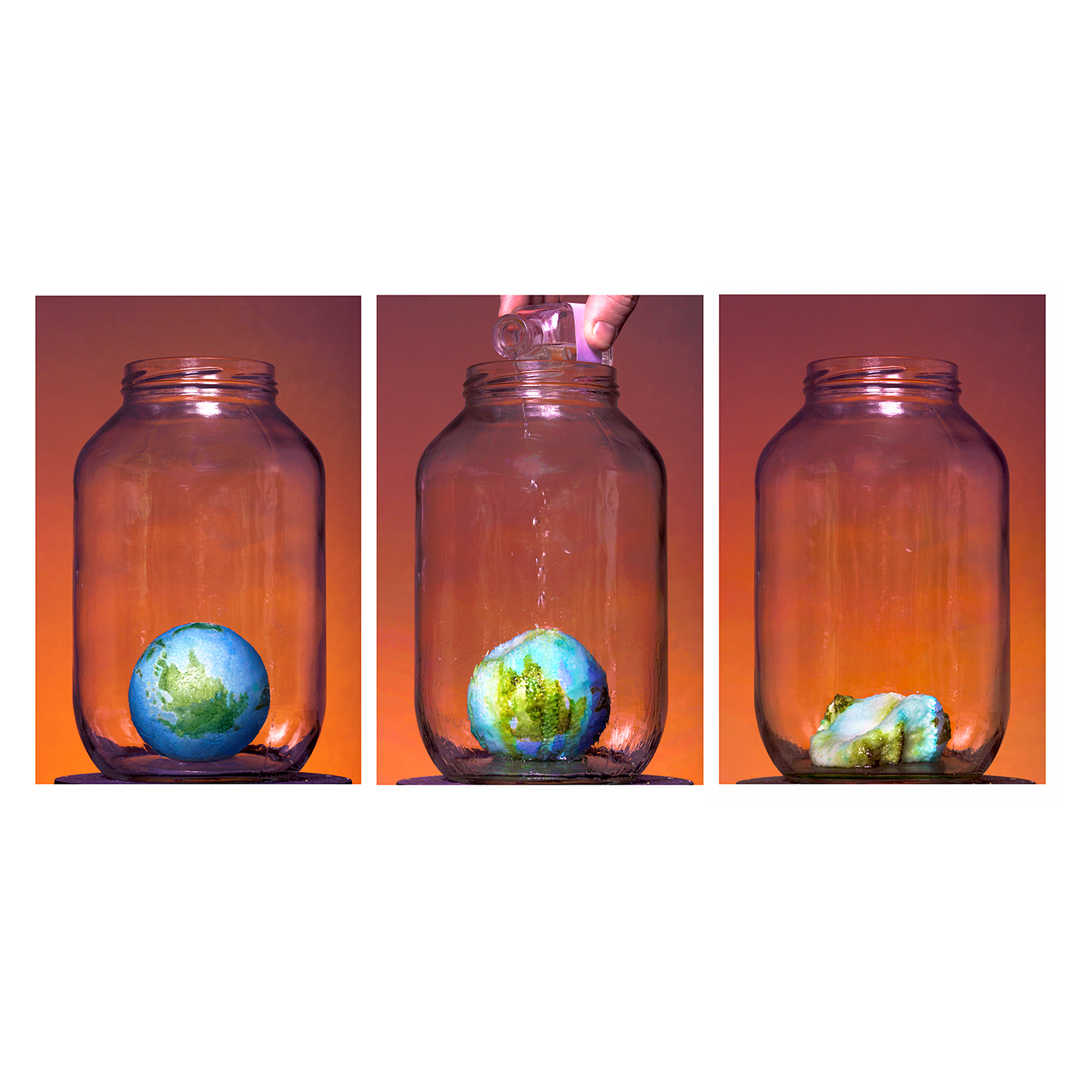
Tiffany Pai
Toxic drops
Changes to the Earth cannot be easily undone. This tryptic explores the idea of human-caused pollution and that even if we stop, the harm we have done to the environment cannot be easily reversed. To shoot this photo, I painted a Styrofoam ball to look like Earth and placed it in a jar. The jar represents the trapped greenhouse gases within our atmosphere. I was inspired by an experiment in science class where we melted Styrofoam with acetone, which is when I decided to melt the Earth in the jar. The acetone represents the irreversible damage we are doing to the Earth. This is a warning that we might be too late.
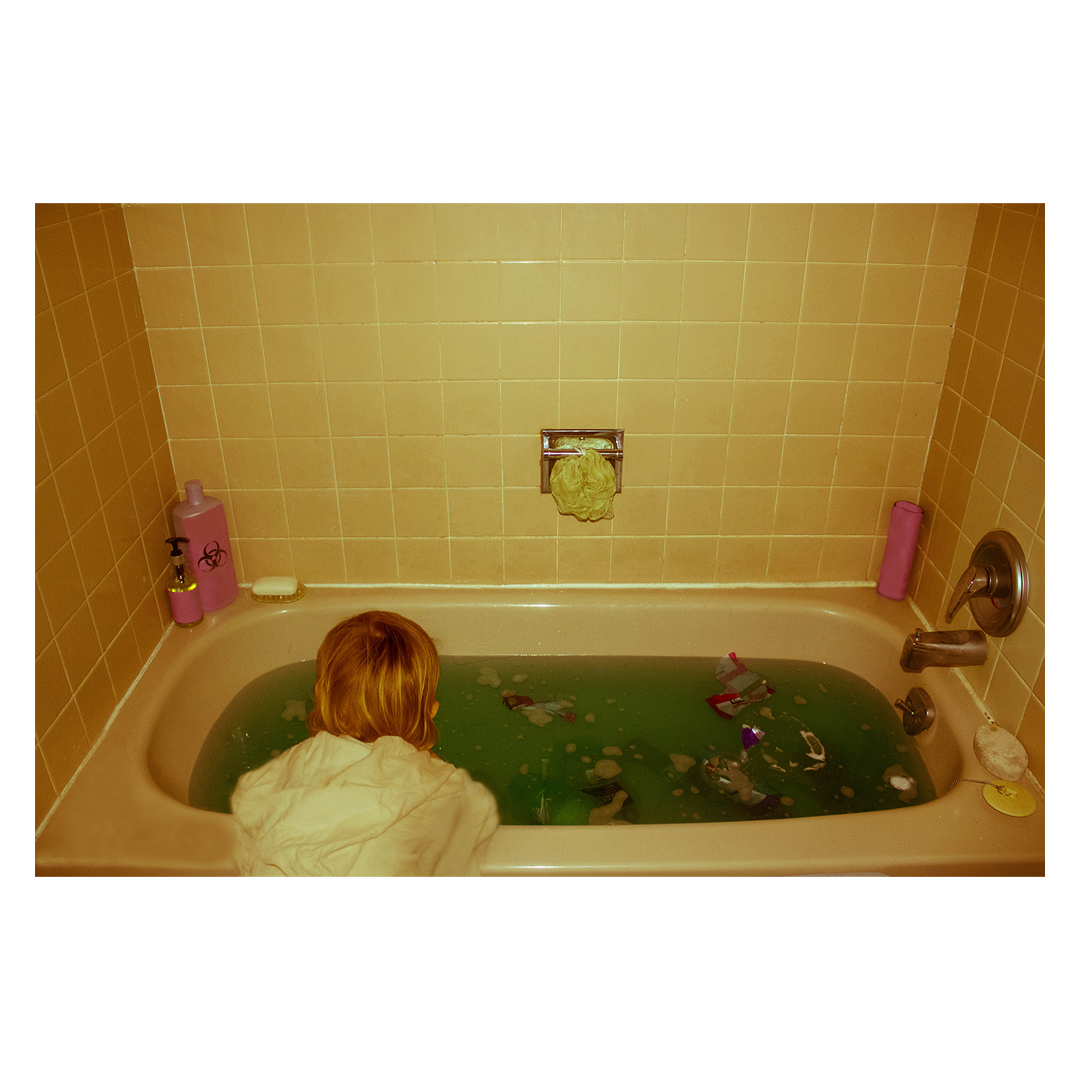
Mariya Demidenko
Plastic Water
In my photograph, Plastic Water, I want to bring to attention the growing problem of ocean pollution and the damaging effect it has on the environment and our surrounding marine life. The bathtub filled with waste is a reference to the polluted waters our marine life are forced to live in, and the oceans that will soon become a standard for future generations if we don’t act now. As a result, the child getting ready to take a bath is subjected to the same littered conditions. The dystopian scene presented is not as far-fetched as it may seem, and the reality may come sooner than we believe.
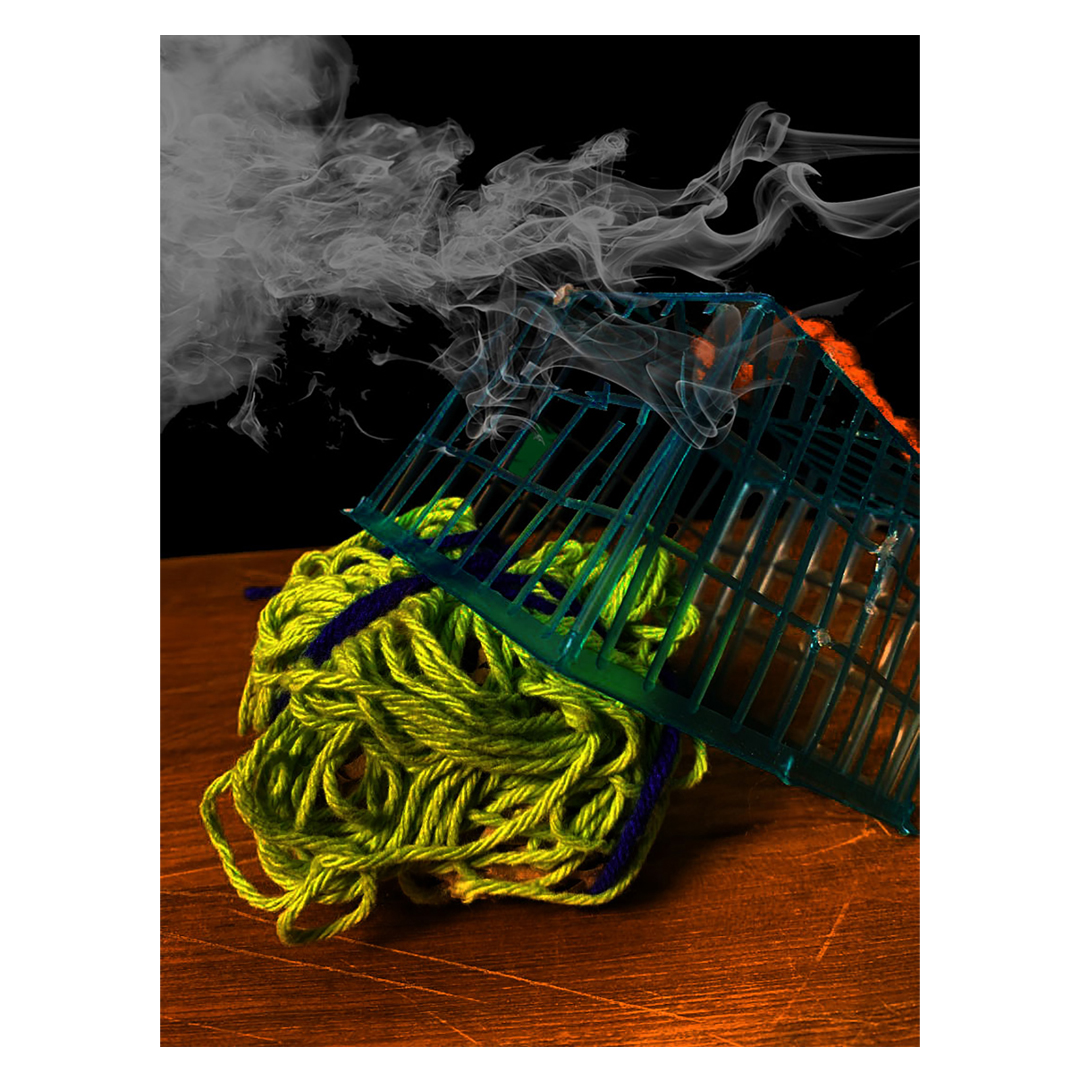
Fabio Carta
Finite World
In the image Finite World, there is a ball of yarn that represent our Earth being trapped by a plastic cage. Plastic is the most polluting material. I also put smoke into the image, representing the pollution. I am an exchange student here in Vancouver and I was totally inspired by the concept of Global Warning. I created the sculpture using some recycled materials and then I edited the image by using Photoshop.
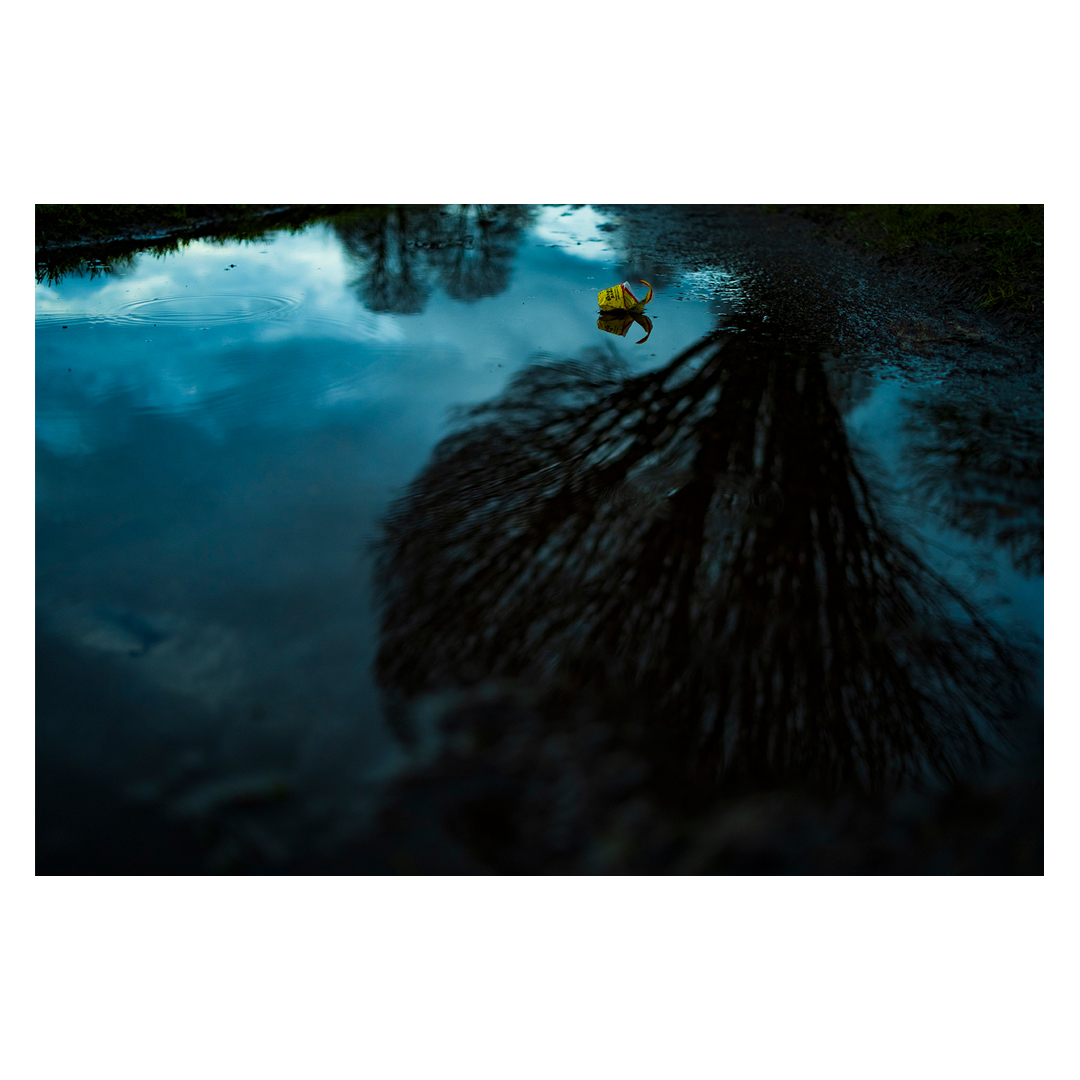
Leo Wang
一叶扁舟
As civilization has advanced, our living environment and sources of necessities have become scarcer. Plastic as an example of artificial material, on the other hand, has been overused by fellow human beings for the past several decades. Now we can see plastic wrap thrown on the ground anywhere, as you can see from my work. My subject was a plastic wrap left on a pond after the rain that almost made it look like a real boat floating on the water. Which is ironic in a way, because maybe one day, we will be living in a world that is full of plastic and there won’t be any boats floating in the ocean but a sea of plastic bottles. Therefore, I believe this photo was worth capturing at that moment. The title of the work is a Chinese term meaning a flat leaf boat.
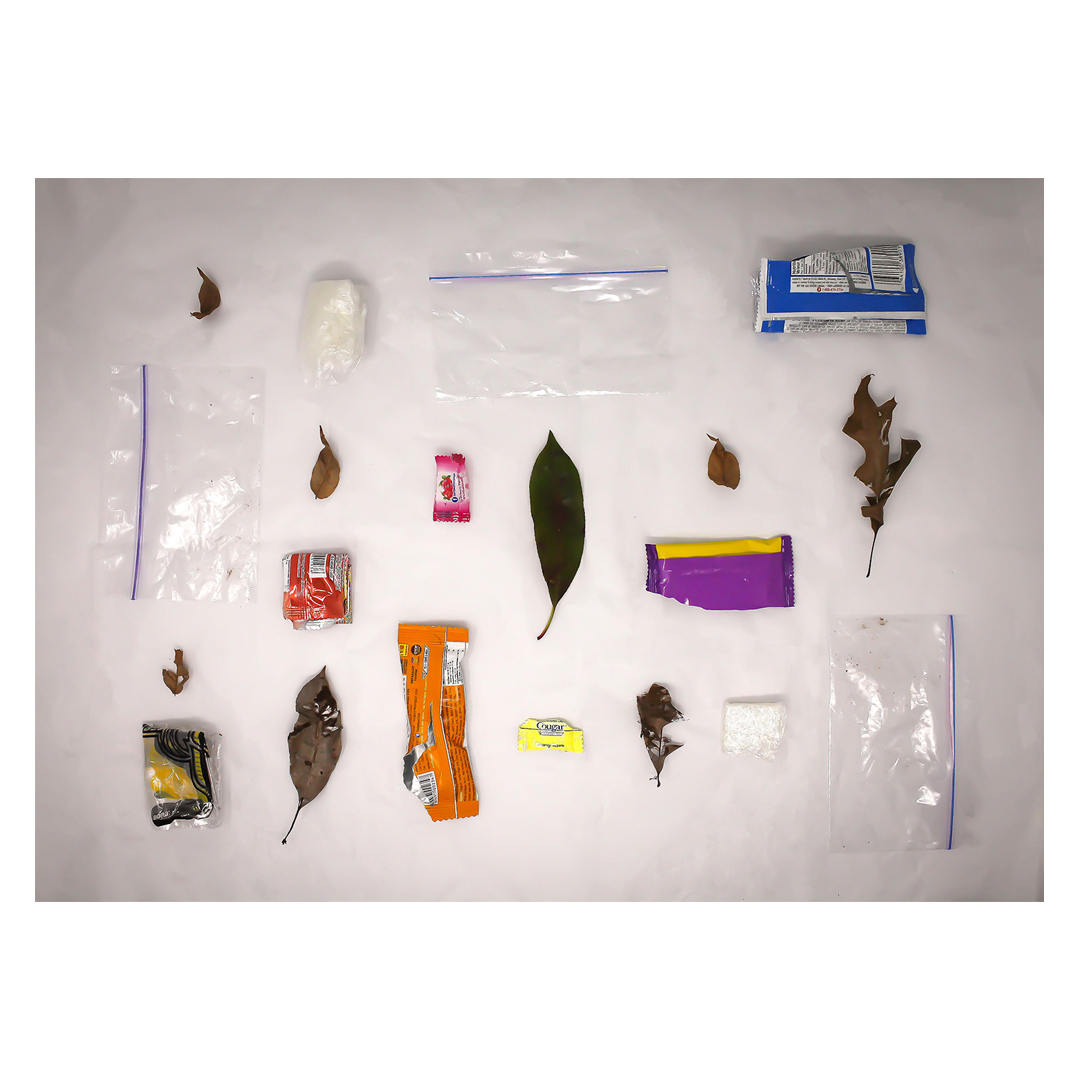
Nutchanat Thanamtieng
Last Chance
This photo is created to reflect on the unconscious use of single-use plastic products. Single-use plastics are designed to be used once and then thrown away or recycled. In the photo, single-use plastic garbage and leaves are scattered all over the place. The old dry brown leaves represent nature that has been damaged by the plastic garbage, and a green leaf in the centre represents the nature that is still healthy but surrounded by the garbage. There are so many products in our daily life that are made out of plastic entirely or partially such as plastic bags, straws, cups, most food packaging, and many more that we do not even realise. Some used plastic products cannot be recycled and usually go to a landfill where they are buried, or plastic gets into the water and finds its way into nature. They do not decompose. They break down into tiny particles. To prevent this from happening, we need to reduce our dependence on single-use plastics.
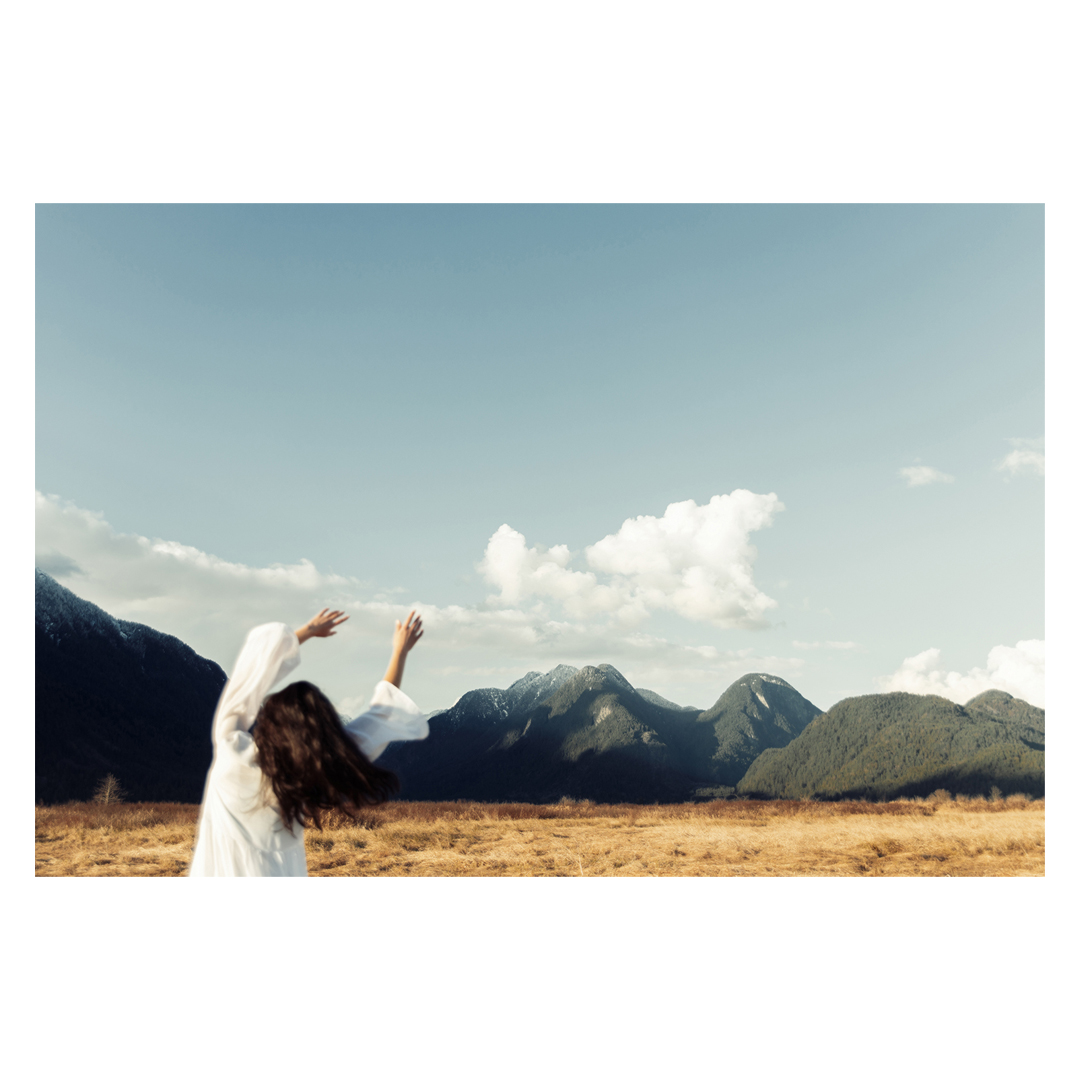
Asalah Youssef
Her Calling (1 of 2)
As a young woman and a climate activist, I am on a constant journey learning about and responding to the imbalance of our current system and worldview with regard to our environmental crisis. Women, youth, and Indigenous Peoples have been at the forefront of the climate movement and yet are consistently absent from the decision-making table, despite the proven fact that when we are equally represented, innovative decisions take place. My work questions the current status quo of the dominant masculine in denial, versus the active feminine valuing of the inherent wisdom of the land and calling out to listen to Mother Nature’s warnings of our changing climate. I use self-portraiture as a tool to question and respond to how humanity holds both of these forms, creating inner and outer turmoil within the climate emergency. When will society begin to put Earth and her warnings in focus?
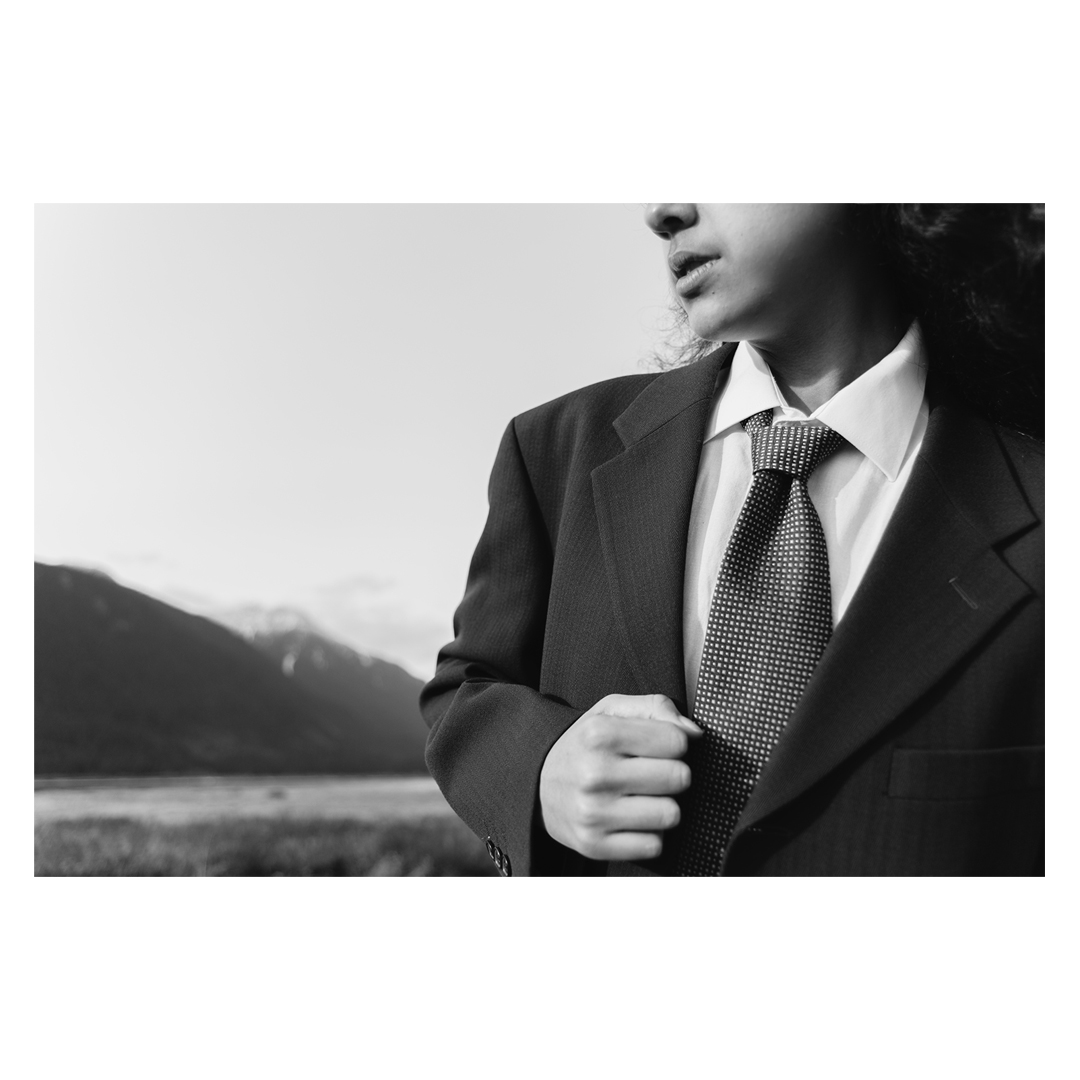
Asalah Youssef
Her Calling (1 of 2)
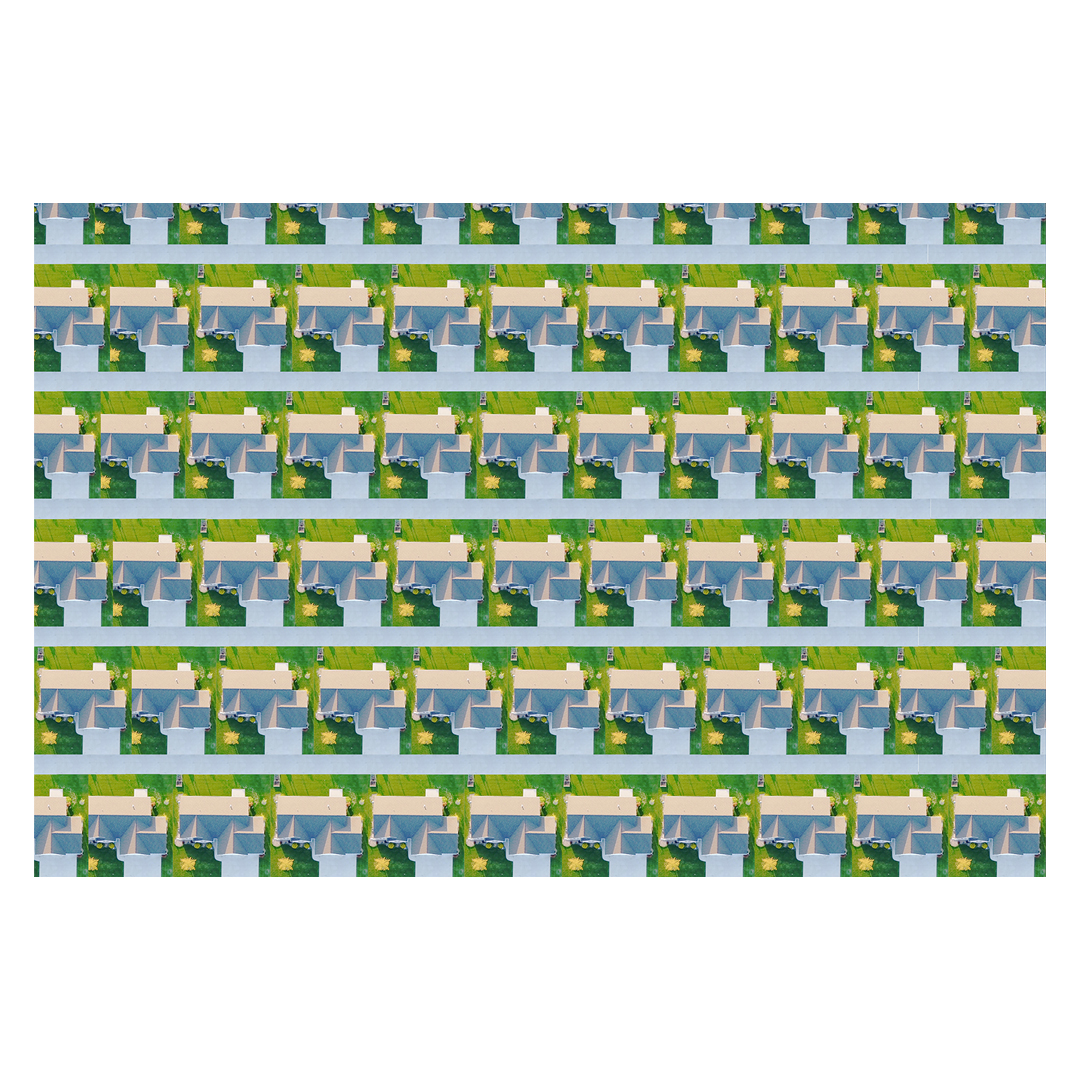
Annalise MacCallum
The New Nature
This image shows how natural landscapes are being deconstructed to make room for human expansion and greed. Using repetition I tried to show human sameness: a phenomenon showing humans not as unique as we like to think we are. The rows of identical, perfect houses represent the artificial world being built around us.
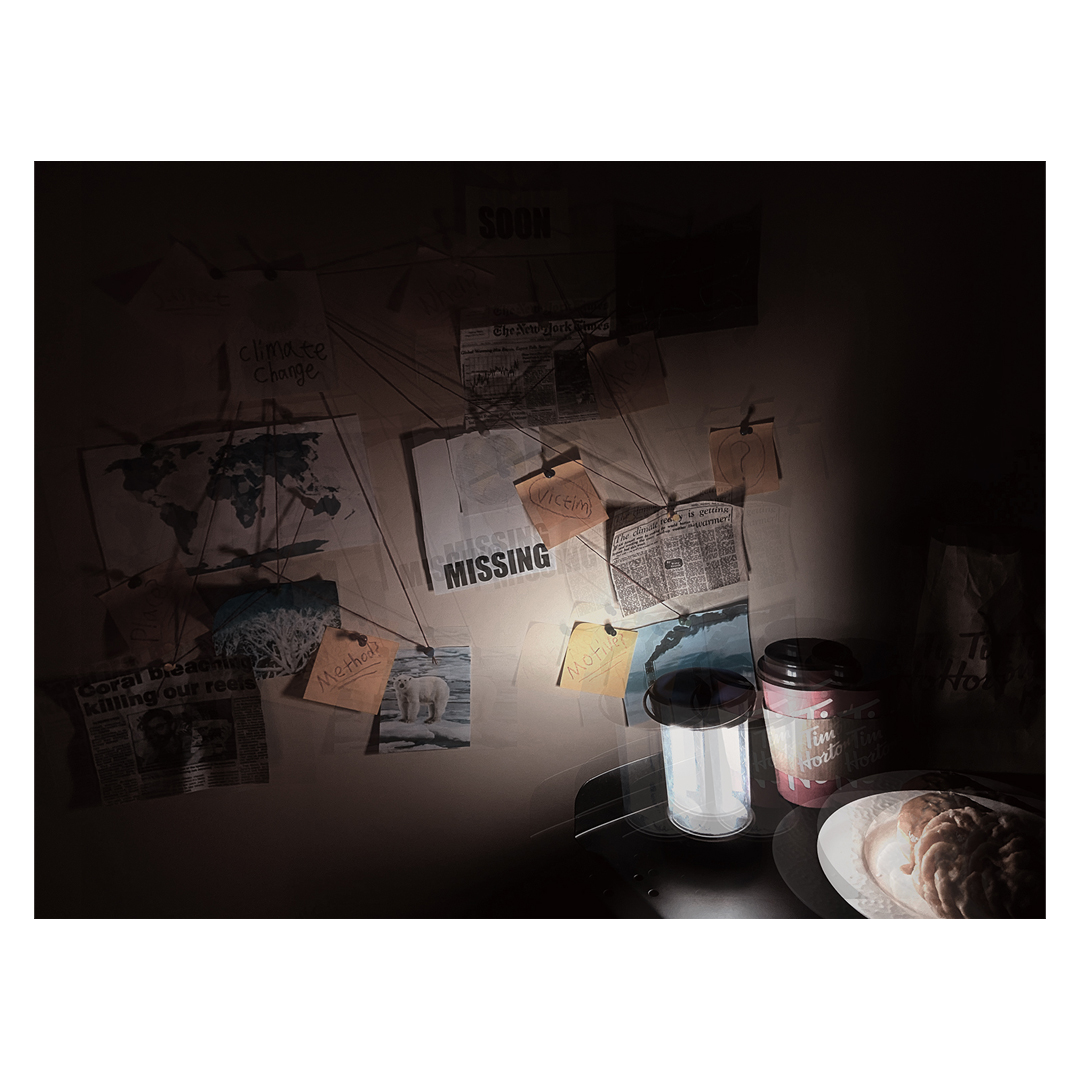
Howard Zhang
Perpetrator
The message of my image is that the Earth is a victim of climate change, who is the perpetrator. The techniques I used to create this image include messing around with saturation, brightness, and exposure levels in Photoshop, and using pastel, string, sticky notes, and thumbtacks for the investigation board. The main inspiration behind my piece is the investigation boards you would see in detective movies like Sherlock Holmes.
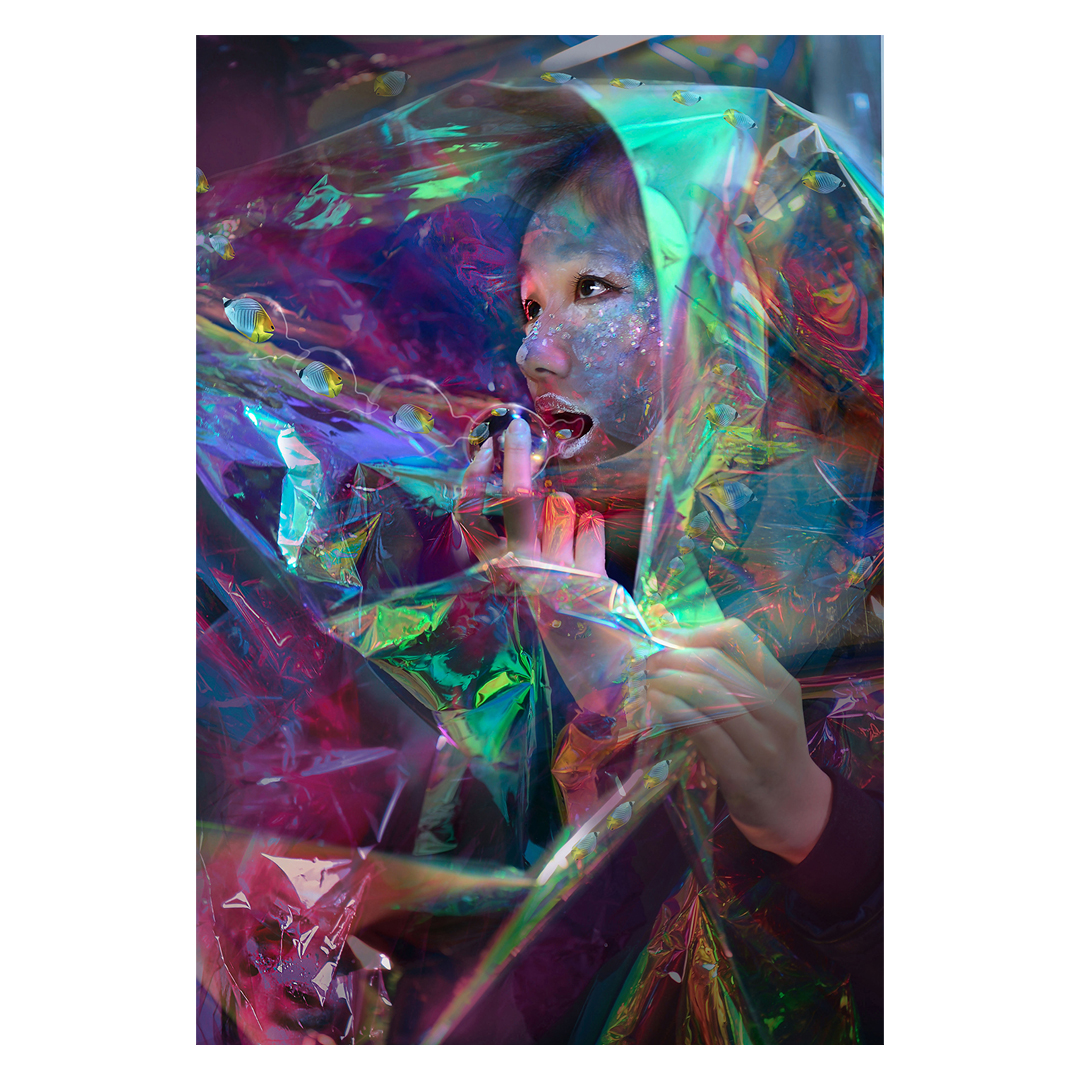
Erin Xi
Personification of oil slick
My piece portrays a personification of an oil slick. Due to human activity, oil slick is a layer of colourful oil that is floating on the sea or coastal region. Such pollution has disastrous consequences for the environment and ecosystem. I emphasise the colourful look of oil slick to portray the juxtaposition between its beautiful look and its hidden consequences. In the image, she, the oil slick, is transparently engulfing the ecosystem of marine life. However, “she” has not shown any emotions. Nevertheless, hidden in the left bottom corner of her face is an image that reflects her real emotion: the helplessness of the human species.
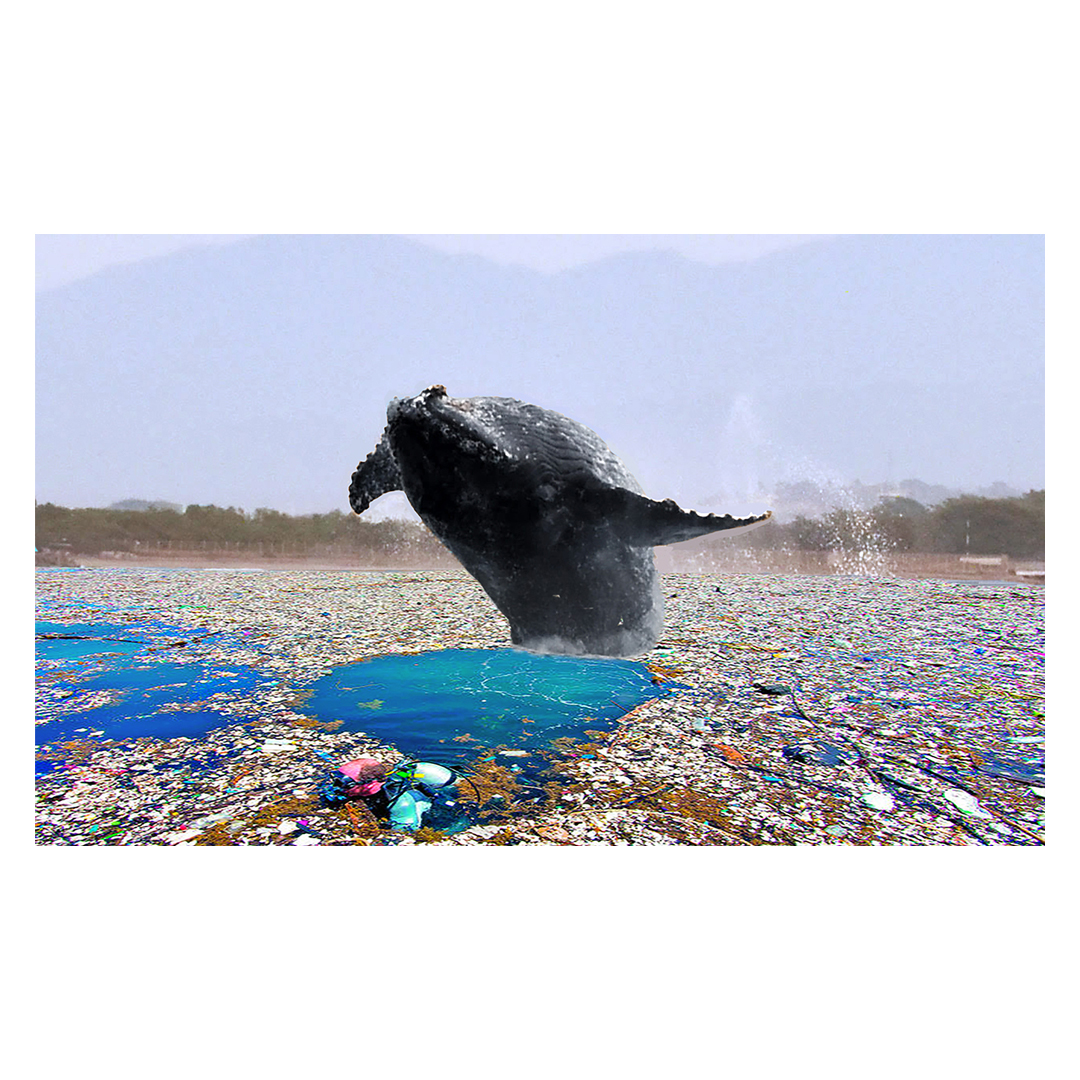
Estefana Arias
Untitled
Climate art is important to me because it’s what is happening now. My original photo is of a whale breeching, which I took in Mexico with my camera. I opened my image in Photoshop. I then searched Google for a photo of waste. After that, I edited the colour of the sky by making it greyer. I increased the vibrancy of the waste, and desaturated the whale. This image talks about climate change, more specifically about the things that it is destroying. The sky is grey because of the industries that are filling our skies with harmful gases, and the waste plastic has more vibrancy because it’s surviving in more places and longer than animals and humans.
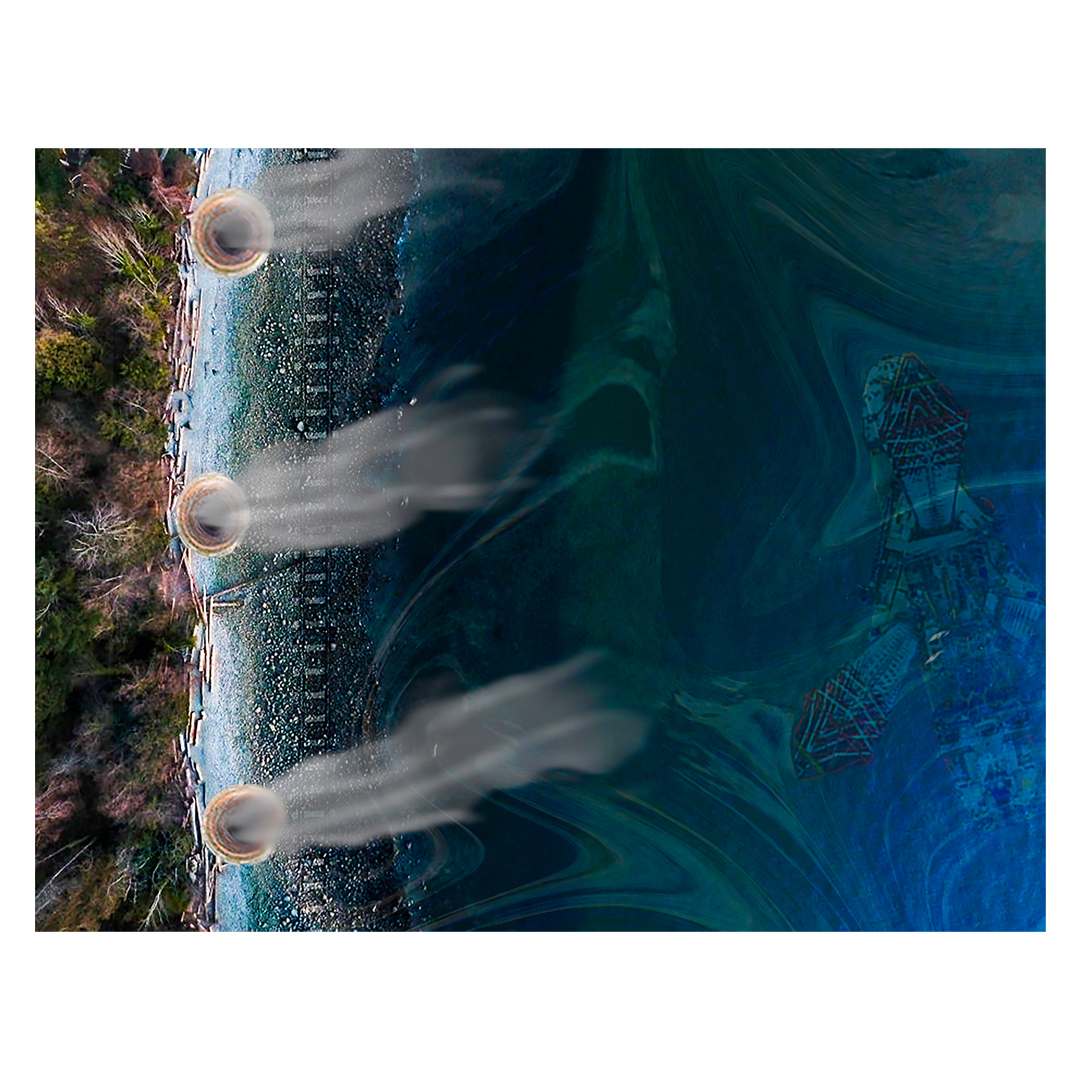
Presley Bosa
Untitled
This photo is representing how industrial machinery is taking away the beauty of nature from this world. The photo focuses the viewer on the oil plant in the water and the smokestacks on the beach, but once you look at the bigger picture, nature distracts you from this. Using a drone, I was able to capture an aerial shot of the coast. Then, through Photoshop, I edited in the smokestacks, the oil plant, and the oil spill in the water.
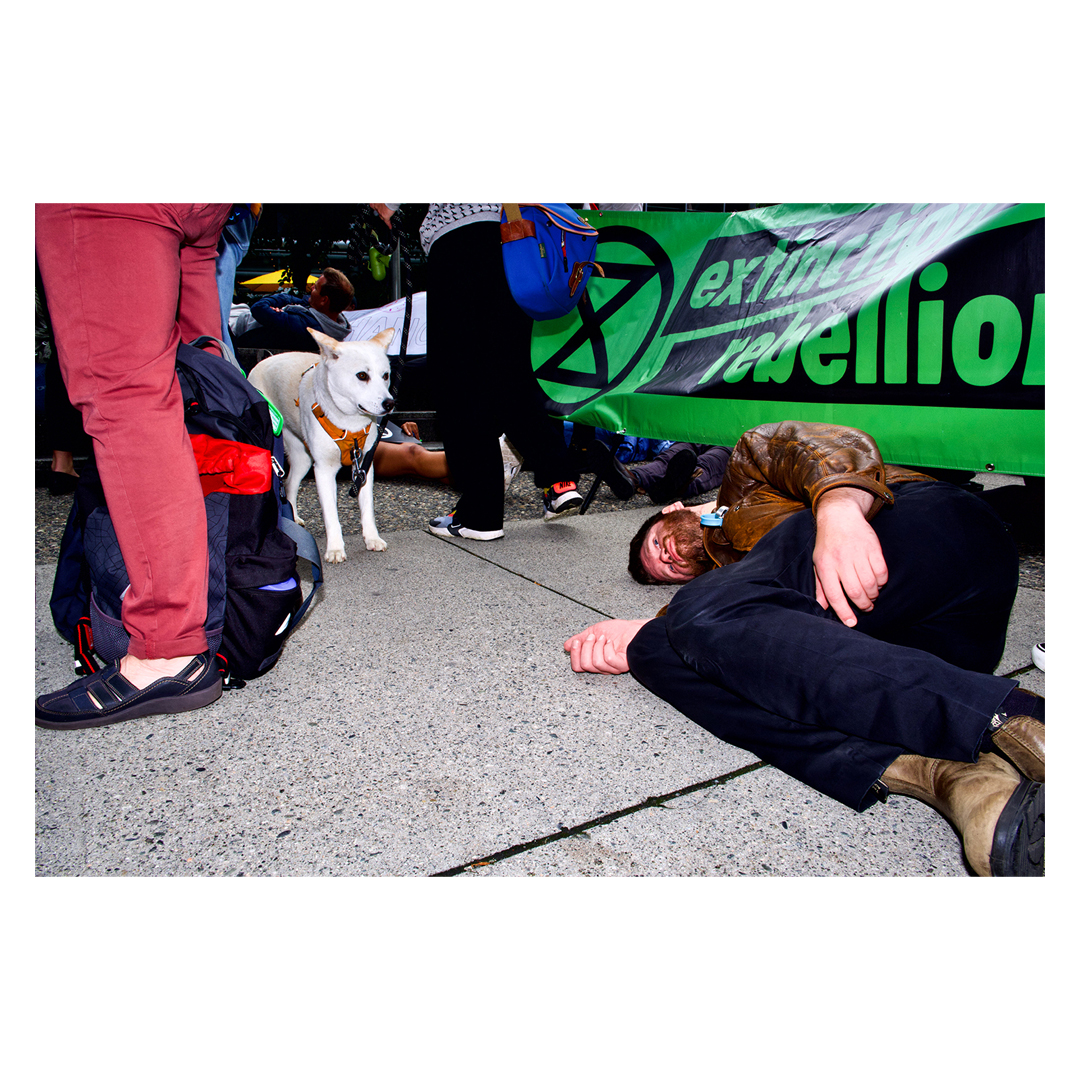
Jason Guan
Dog and Man
I’m fascinated by the beauty and complexity of humanity and dedicated my work to photograph human life. So far I’ve photographed climate change and sustainability-related events five times, and as an observer, I got to learn about people’s varied opinions on the environment. Under the influence of Greta Thunberg, many more young people and the elders have raised their sense of protecting the Earth, and have begun to take actions like protesting and marching to state their dissatisfaction about the government’s lack of action. At the same time, the blockage around the city created a lot of inconvenience for the public. Is this actually an effective way to save our planet or a misguided action with a good intention? We shall see in the future development of our society.
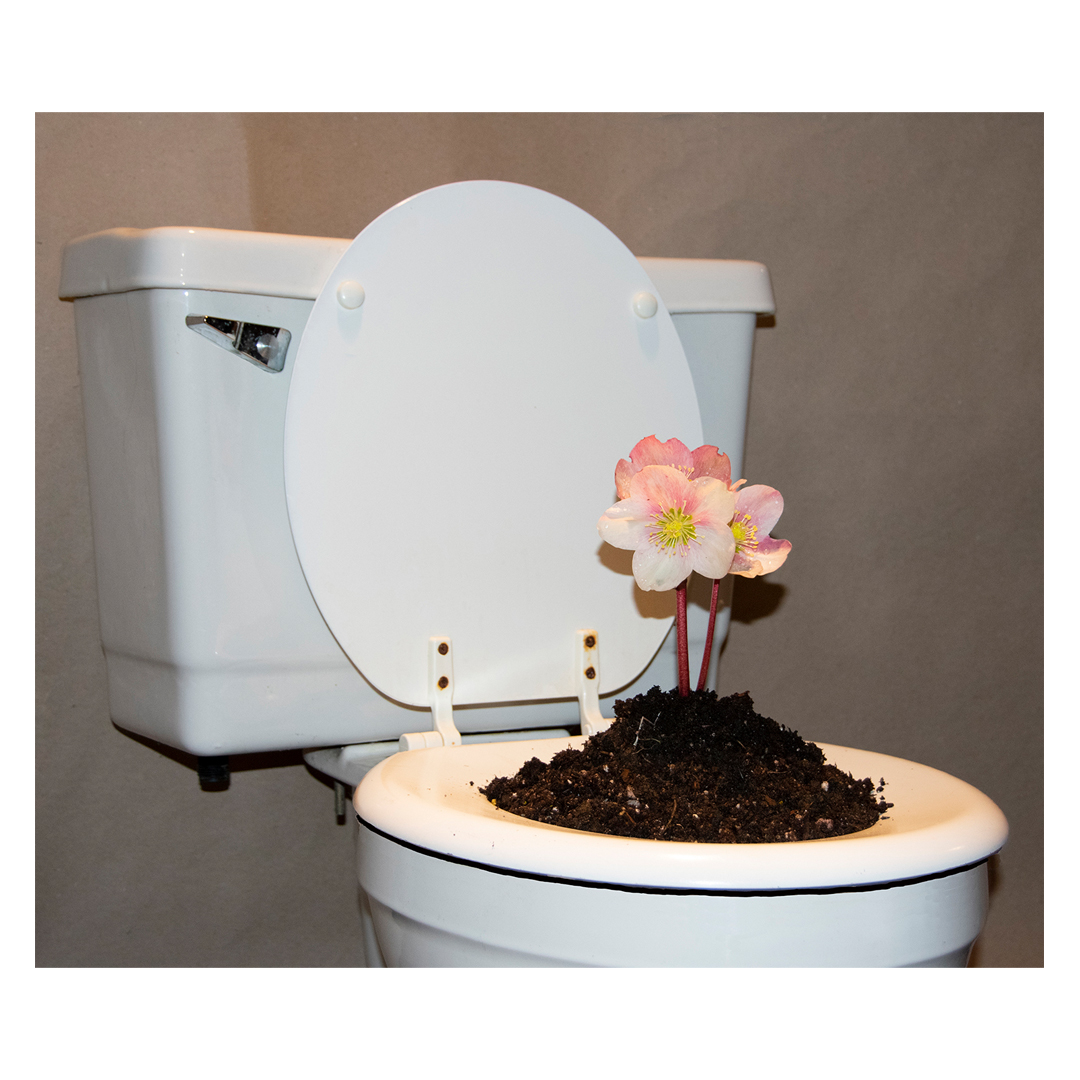
Sophia Afshar
Flushed Flowers
As an artist, I wanted to express how our environment is being “flushed away” right in front of our eyes. The toilet demonstrates the tragic pollution and destruction of nature that is happening around us, while the flowers show the beauty in the environment that we still have hope in saving. Many of us are aware of the impact of global warming because it is on the news daily. However, people become complacent when they are bombarded with negative news. My work attempts to provide an image that is both familiar and incongruous. The viewer may smile at first, but then may feel motivated to do their part for the environment.
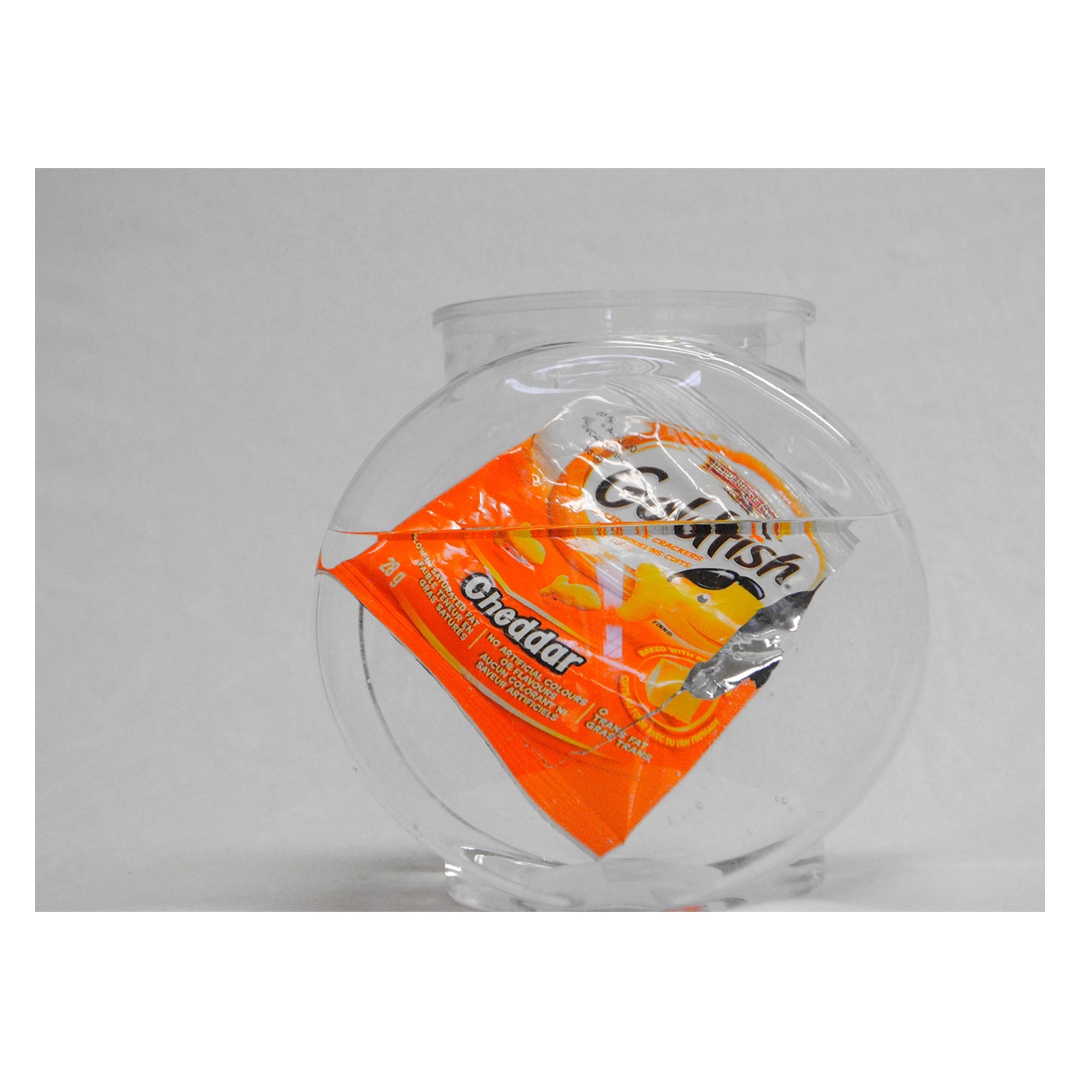
Julia Keil
Synthetic
“Our oceans could contain more plastic than fish by 2050.” – UN Environment Programme
I exemplified the meaning of this quote in a clashing image, capturing the tragedy of the estimated future waste in the Earth’s oceans. Many have a memory of a pet fish in their childhoods, as well as fun and colourful snacks. I utilised these images to strike nostalgia that comes with materialism. Together, these innocent images create a dark message portraying how as Gen Zs grow up, we will all get slammed by a reality that was present all along: climate change.
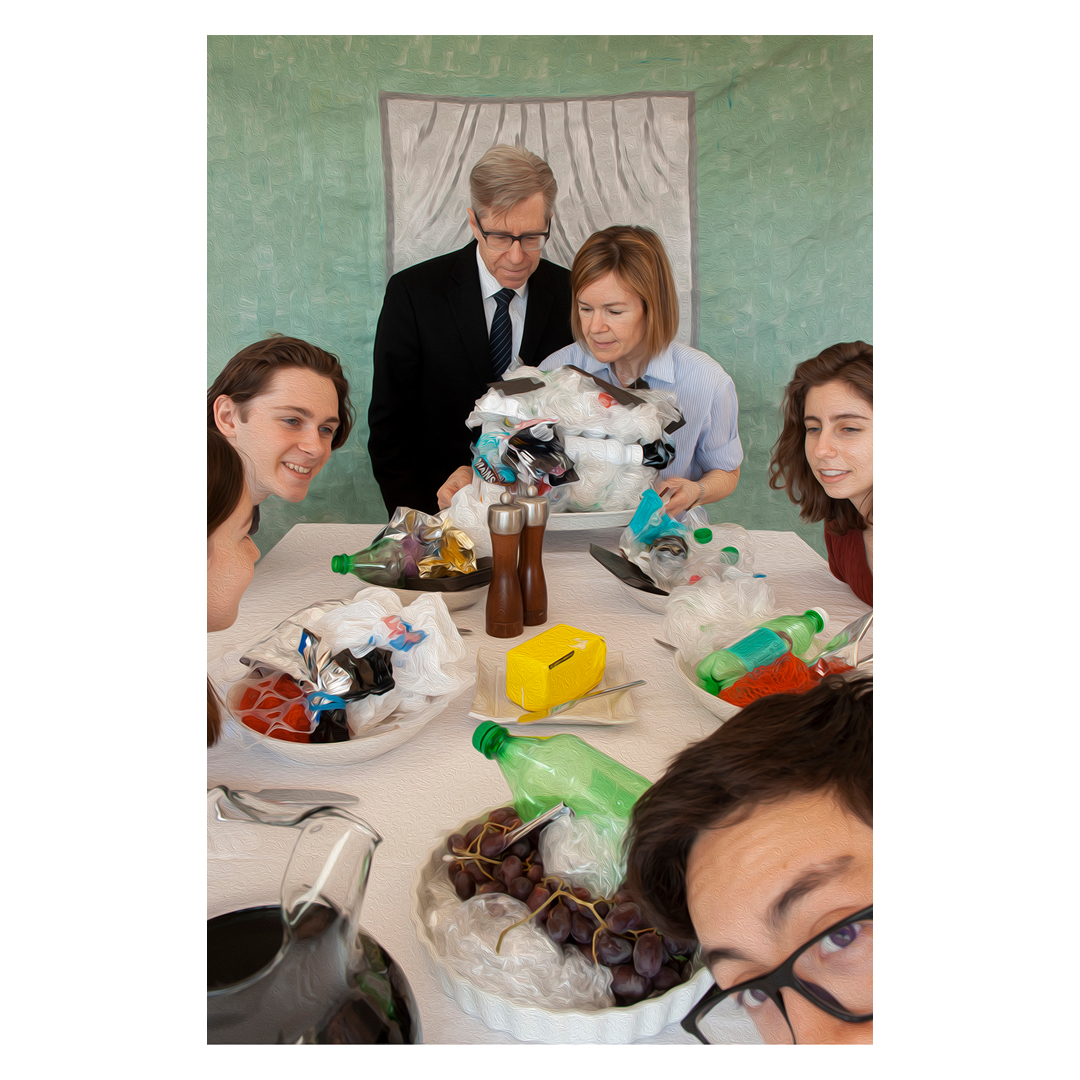
Charlotte Degenstein
No Freedom
In my piece, No Freedom, a family is seated at a dining table for dinner; but rather than food, the plates are filled with garbage. My photo references Norman Rockwell’s painting Freedom From Want, which depicts a bountiful Thanksgiving dinner. The painting’s message is about the right to be free of want, and that we should share what we have with others. In contrast, the trash in my photo is placed in the setting of a family dinner to represent what animals have to eat in comparison to the abundance available to humans. Human selfishness forces wildlife to live among garbage, so we must share what we have (land, resources, etc.) with wildlife who suffer.
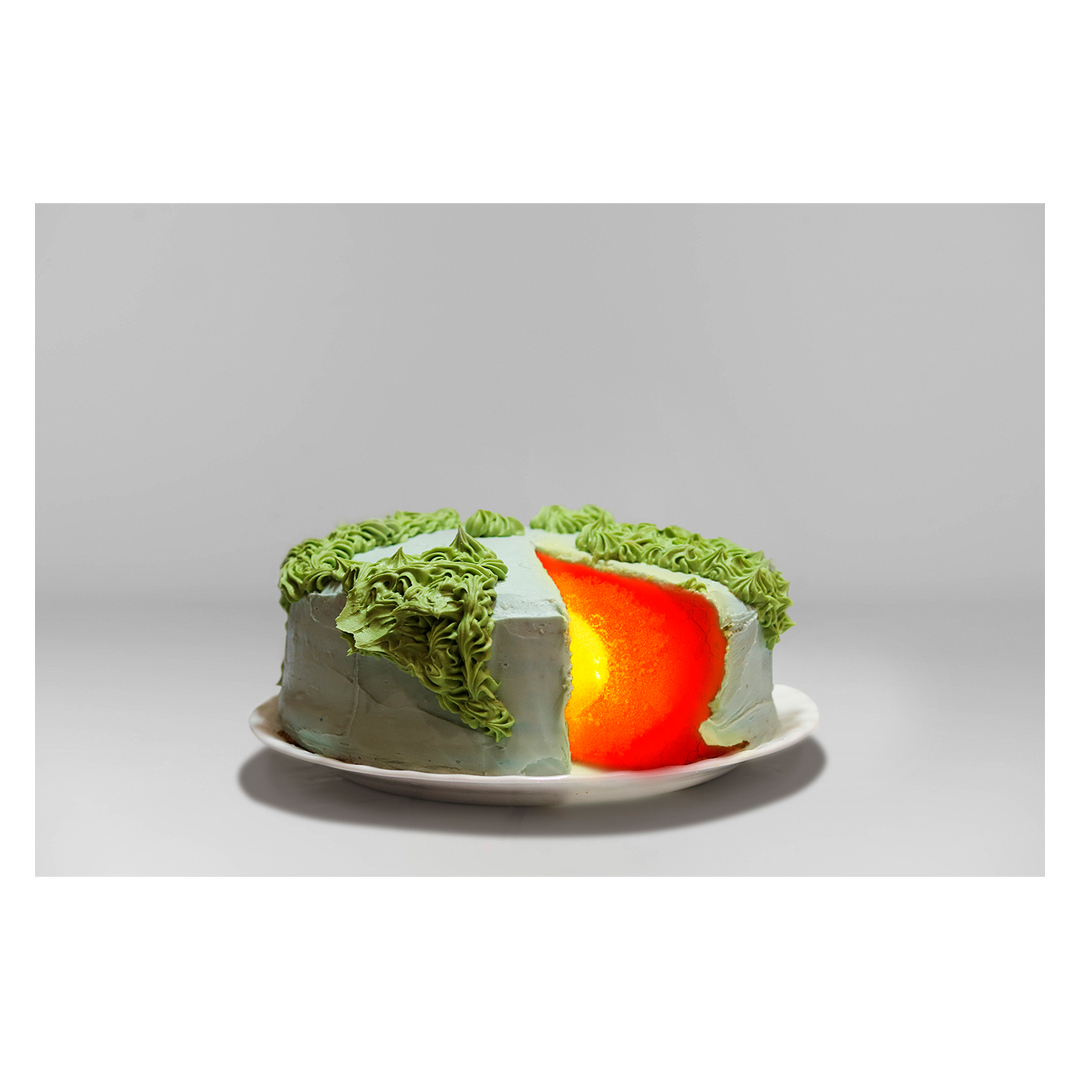
Doris Ni
Last Birthday?
The Earth as a human might be the strongest yet most damaged of us all. The Earth as a human may not have many more birthdays to celebrate. I created this image to bring awareness to the lack of promise for another year for our planet. The cake is decorated to look like Earth and, using Photoshop, I recreated the Earth’s core within it.
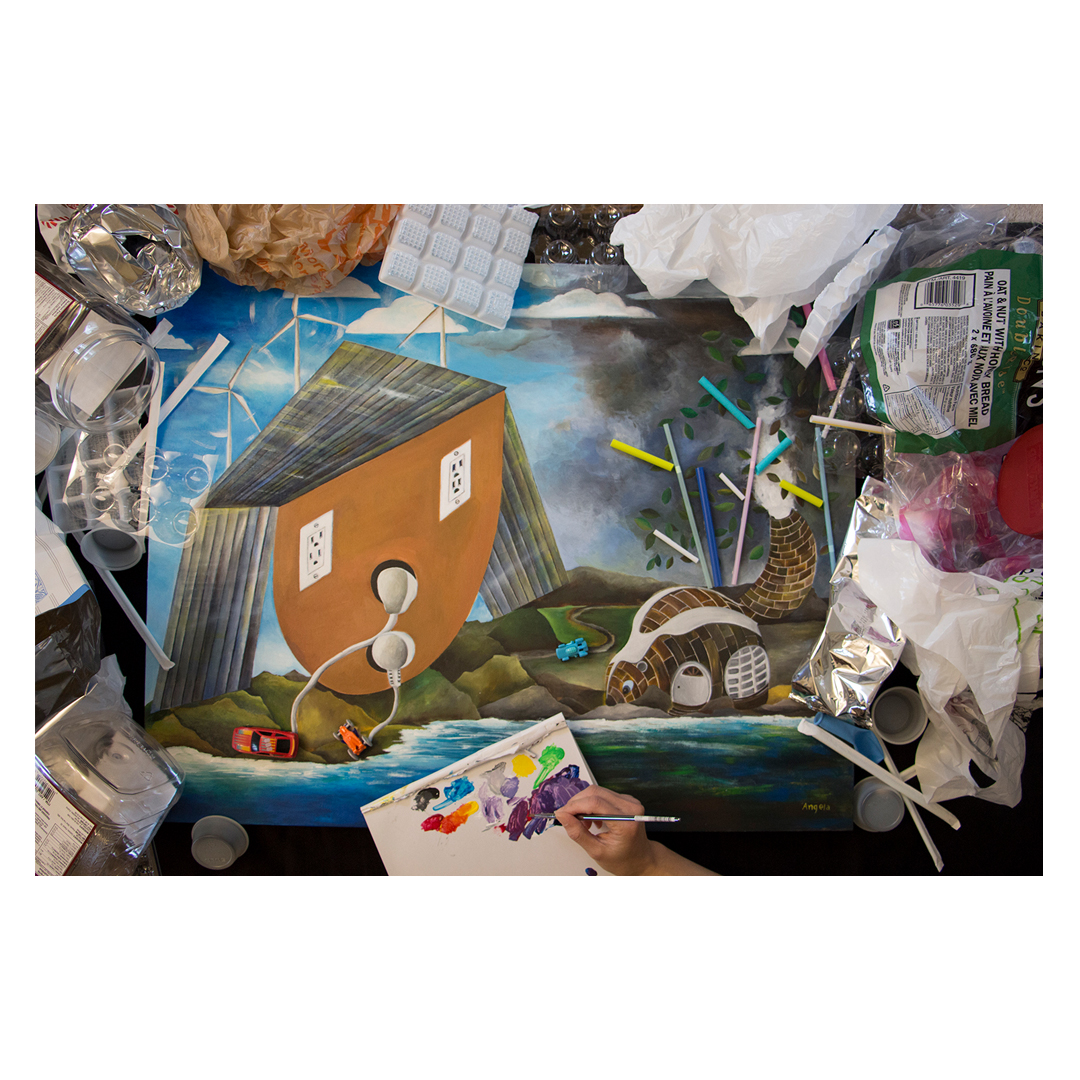
Angela Chen
Your Problem, Too
Most of us claim global warming to be important, yet many of us do nothing about it. I represent this hypocrisy by contrasting an artist against their use of plastic. The artist creates a painting to illustrate the critical state of our world; at the same time, we see the reality of her personal choices. This juxtaposition aims to target the ignorance that is far too common today. What we say is simply not what we do.
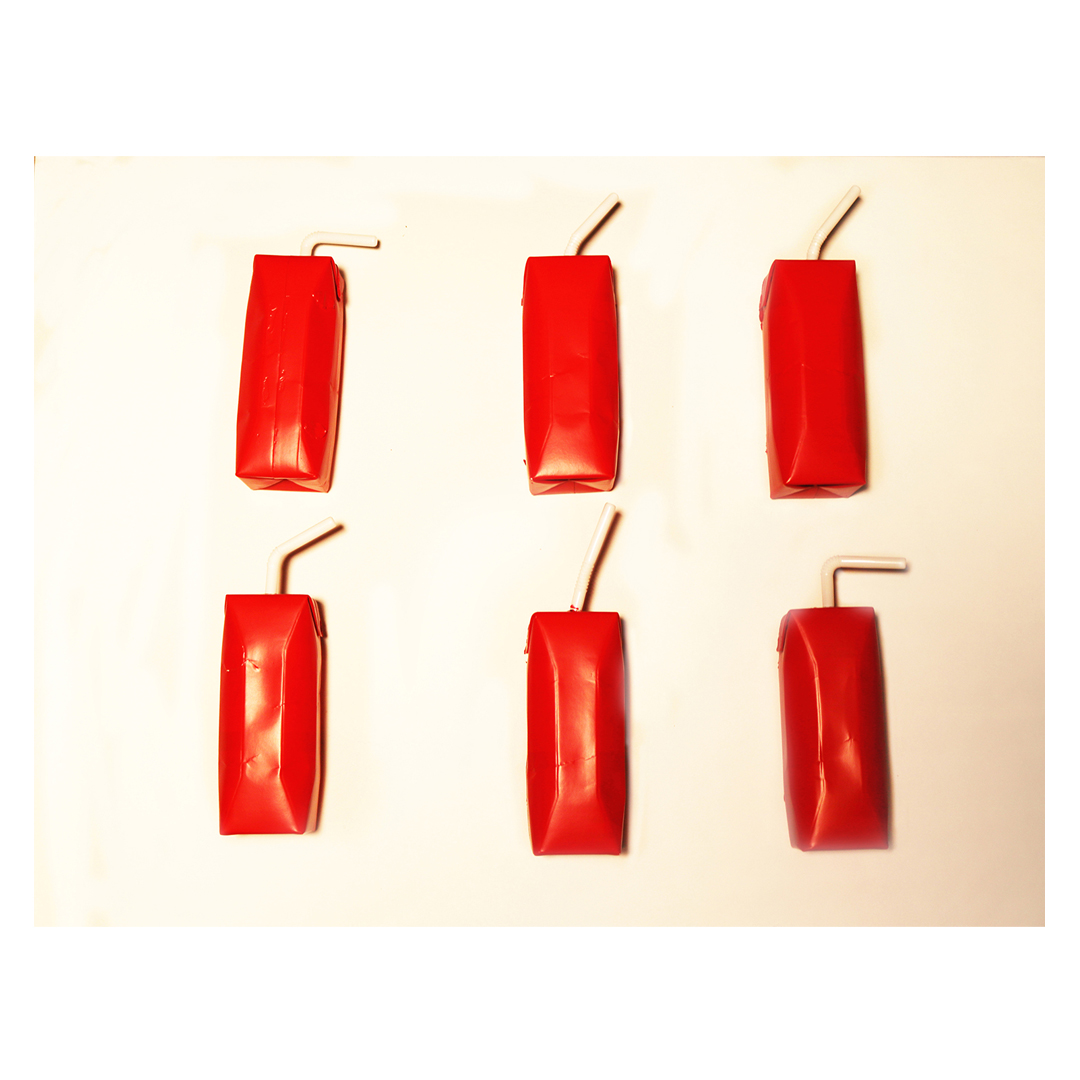
Isabella Lawton-Giustra
Modern Factory
I collected juice boxes over the course of a week; I assumed that this part of the project was going to be the most time-consuming but the shocking part was that it took me around three days. I used repetition of the juice boxes and tried to make everything identical, clean, and modern. By spray painting the juice boxes red, a theme of “warning” is implied, and yet the image looks calm and orderly. The idea behind my image is that in modern society, we are continuing to create a long line of garbage for the next few generations. I wanted to symbolise the factory line of garbage that we are making with single-use materials.
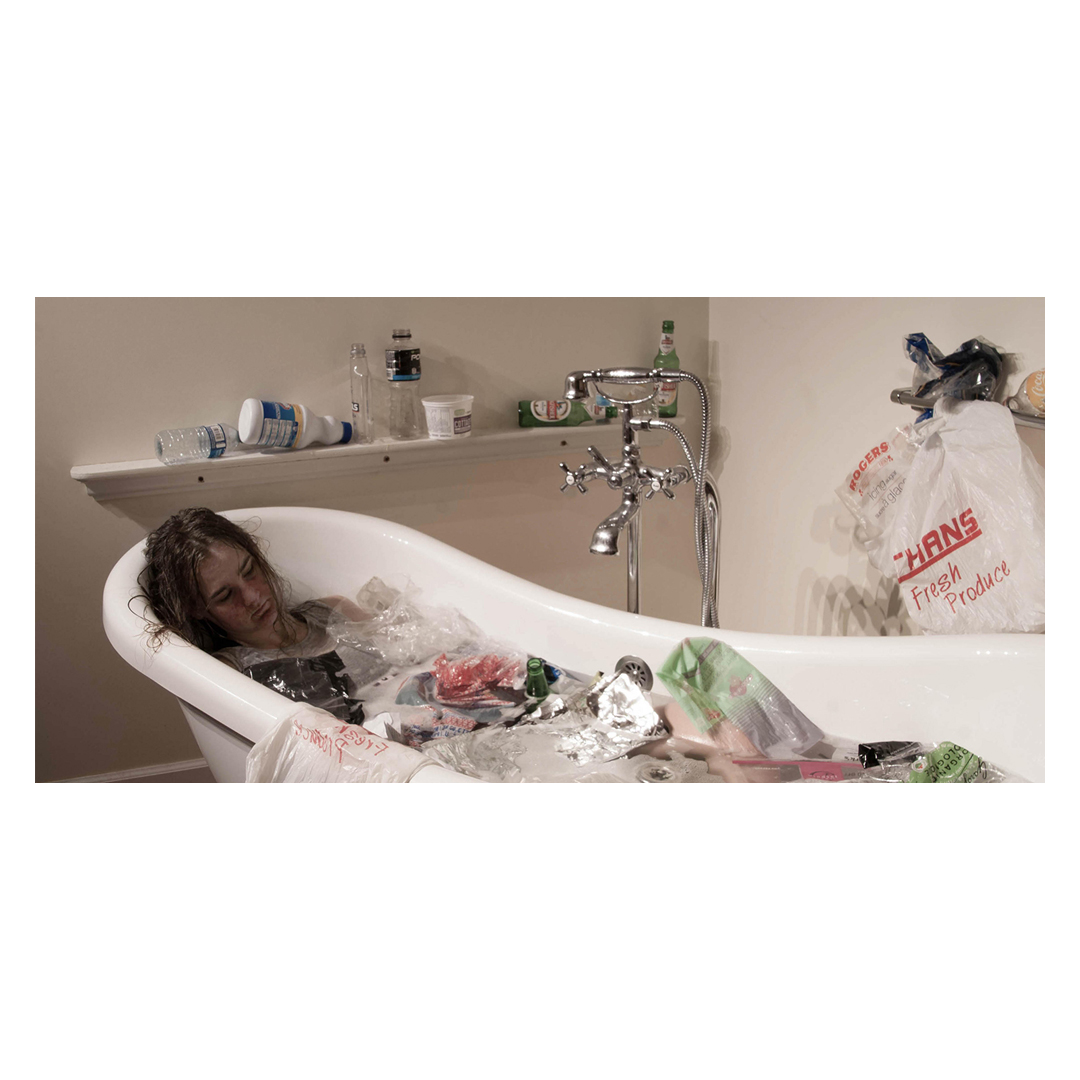
Etienne Boisclair-Joly
Only Us
My Grade 7 teacher often liked to show us interesting YouTube videos. I remember watching a simulation in which all the humans on Earth vanished at once. It was bizarre but the results amused me. Nature rapidly took over our previous existence. Buildings and bridges crumbled astonishingly fast, lush greenery regained its place over our society, and animals began to thrive. Everything was at ease once more. My image is a representation of what we, as humans are doing to ourselves here on Earth. I want to spread the message that planet Earth will live on, survive without our species. By smothering ourselves in waste, who will it come back to bite? Only us.
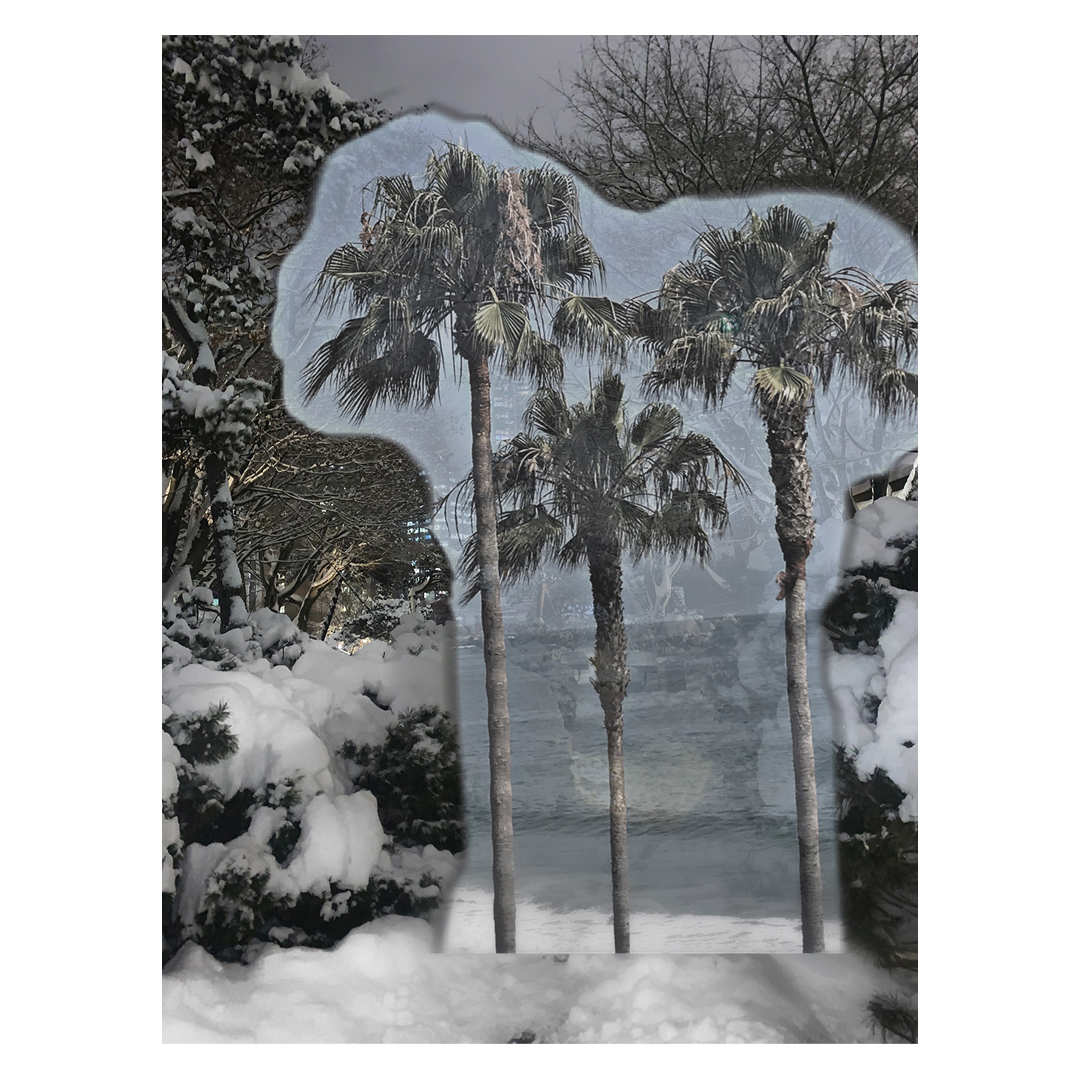
Lolita Markushevska
Tropical Blizzard
The theme is climate change’s effect on our society. The picture symbolises that these days winter is not as severe as in the past few decades. The palm trees represent warm temperatures; respectively, the snowy background stands for the extreme weather events that are taking place throughout the year. The image is made of two photos that were taken by me in Laguna Beach, CA, layered against a background photo that is from Vancouver, BC.
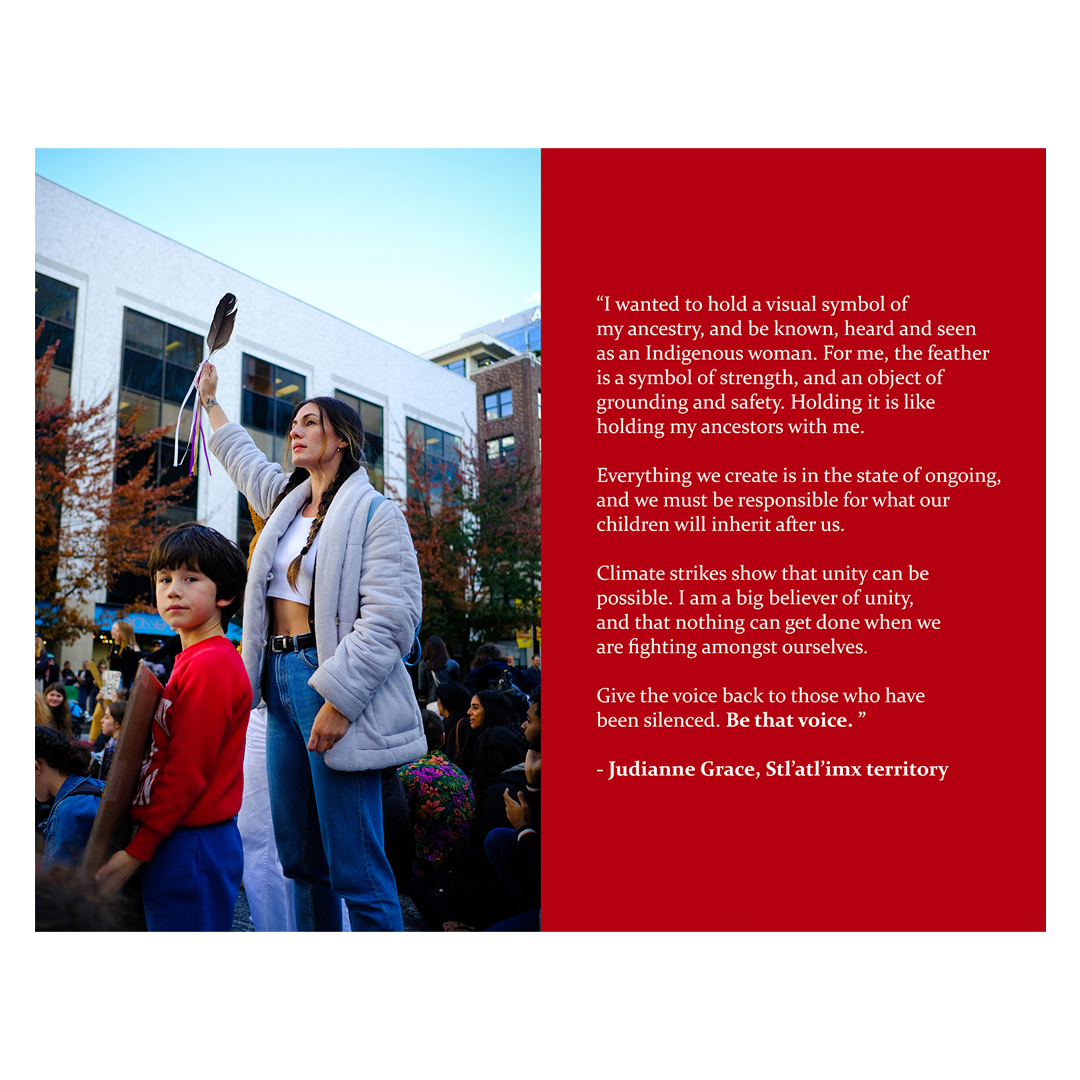
Anova Hou
Voices of Silence
I photographed Judianne Grace of the Stl’atl’imx territory with her son Maverick during the Vancouver Climate Strike. I saw her stoic face and strength of her protest, an image of resilience and protection for our Earth and youth. My piece addresses the need for voice, unity and Indigenous representation during this time of climate crisis.
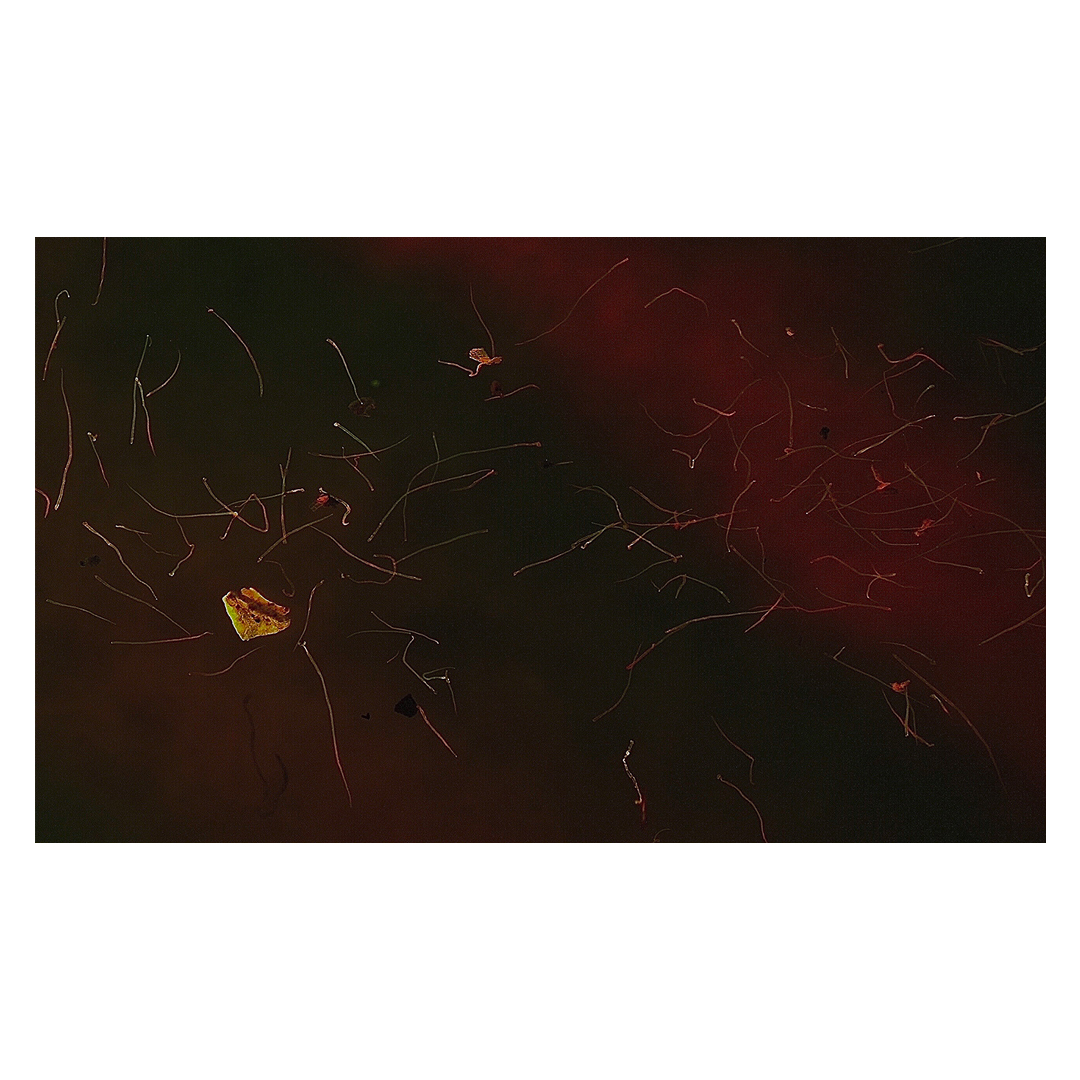
Mackenzie Coleman
Small Warnings
For this year’s theme, I wanted to expose the truth about microplastics. Using a high-powered microscope with a built-in camera and a chemical dye I was able to show the scary truth. The dazzling vibrant particles in my image are the microplastics, which are illuminated by certain wavelengths of light after reacting to a dye called Nile Red. To extract the microplastics I steeped an empty tea bag overnight, which claimed to be made of silk and all organic. The amazing results show a shocking amount of microscopic plastic to be present after the tea bag was steeped. These microplastics are being flushed into our bodies and then out into the wider ecosystem. This one example seems small, but microplastics are being produced around the world from just about every source of plastic at massive levels, contributing to climate change in catastrophic ways. Each small piece of plastic produces methane and ethylene when heated, and these gases get absorbed into our atmosphere and slowly warm our Earth. The hotter the Earth gets, the more plastic will emit harmful greenhouse gases. These microplastics are absorbed by plankton in the ocean and may inhibit their ability to absorb carbon from our atmosphere, reducing the ocean’s effectiveness as a carbon sink to remove carbon dioxide, another greenhouse gas, from our atmosphere. I hope by spreading awareness of the fact that microplastics are produced in many things that we use every day such as “silk”en tea bags, clothing, and cleaners, people will start thinking about ingredients and the global consequences of the products that they buy.
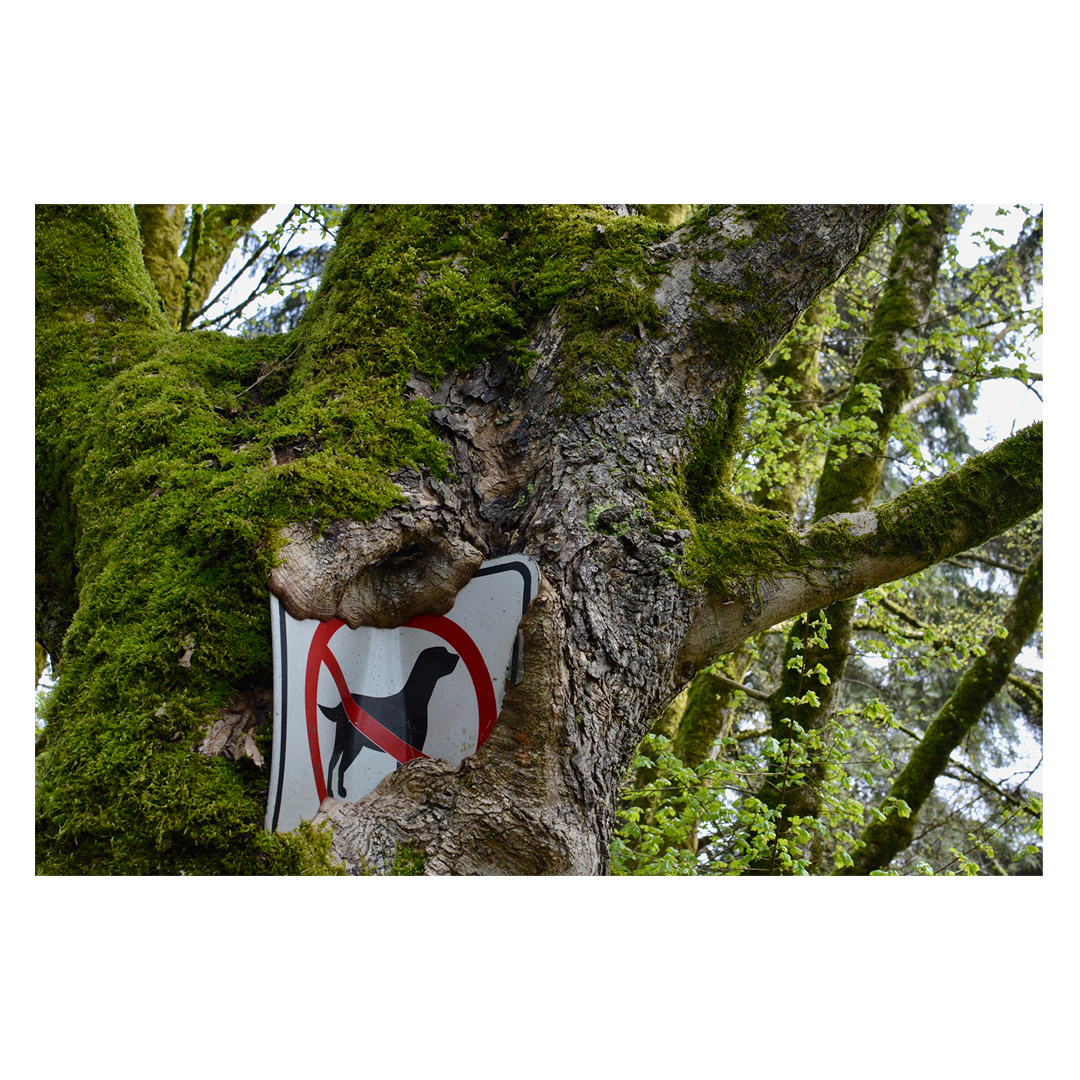
Anna Bryan
Force of Nature
I took this photo in a West Vancouver park while on a nature walk with my class. It represents the theme of Global Warning because of the interconnections between nature and human materialism that is so clearly visualised. This picture captures how although we as a species have placed ourselves above nature, time will forever favour Mother Earth as it will always adapt. I love how the sign has been manipulated over time by the tree, bent out of shape by the strong force that is nature.
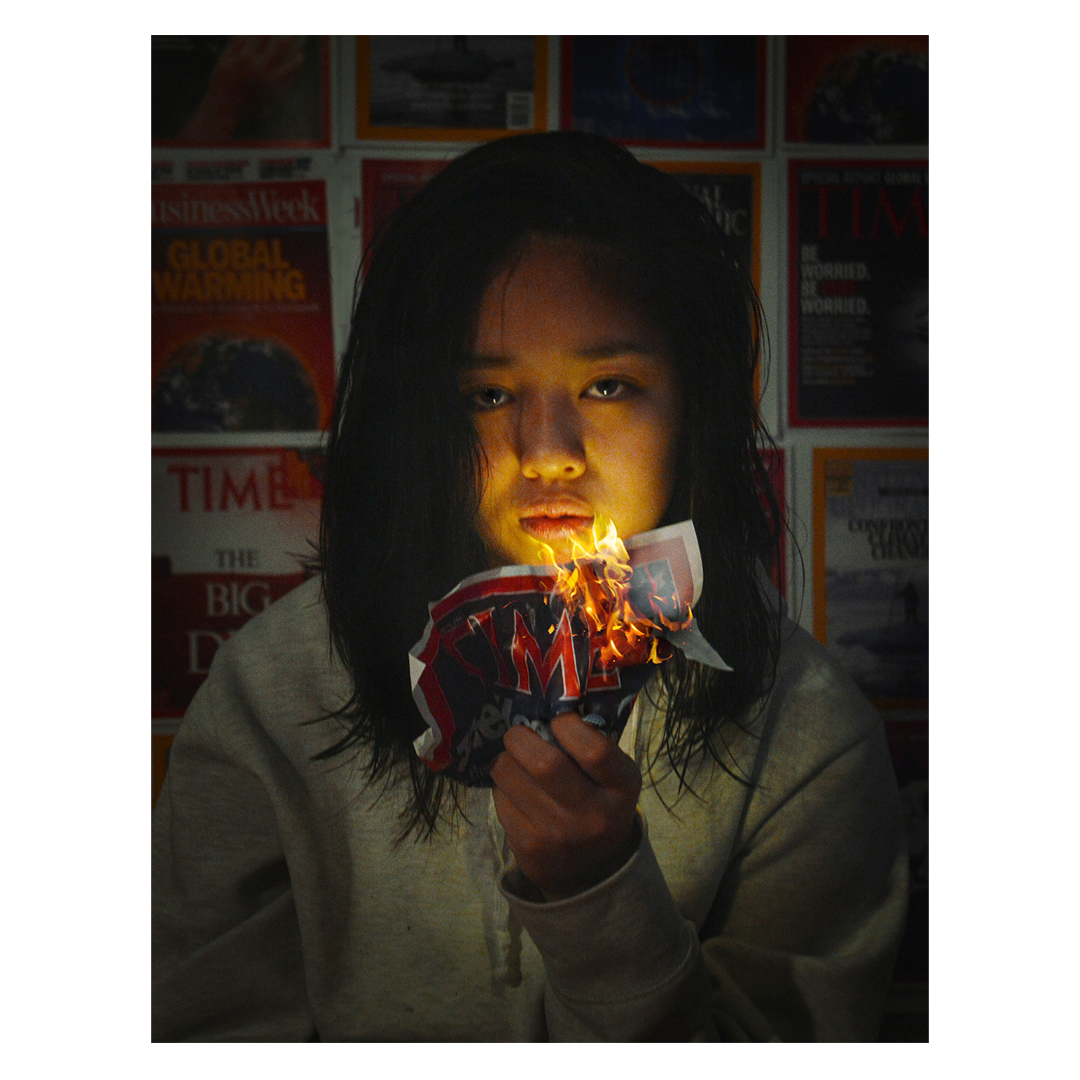
Alice Lee
WARNED
WARNED explores the dangers of unopened ears towards the repeated warnings of the negative impact to our environment. The magazines in the background, issues ranging from decades ago to recent publications from the past couple of months, portray the warnings that have been cast countlessly to our world about the consequences of our actions that damage our planet. Yet despite numerous warnings, there are still unopened ears that spread other dangerous ideas. Ignorance lights a fire towards a pathway of chaos and disorder, and will inevitably overturn the rates of survival for the human race.
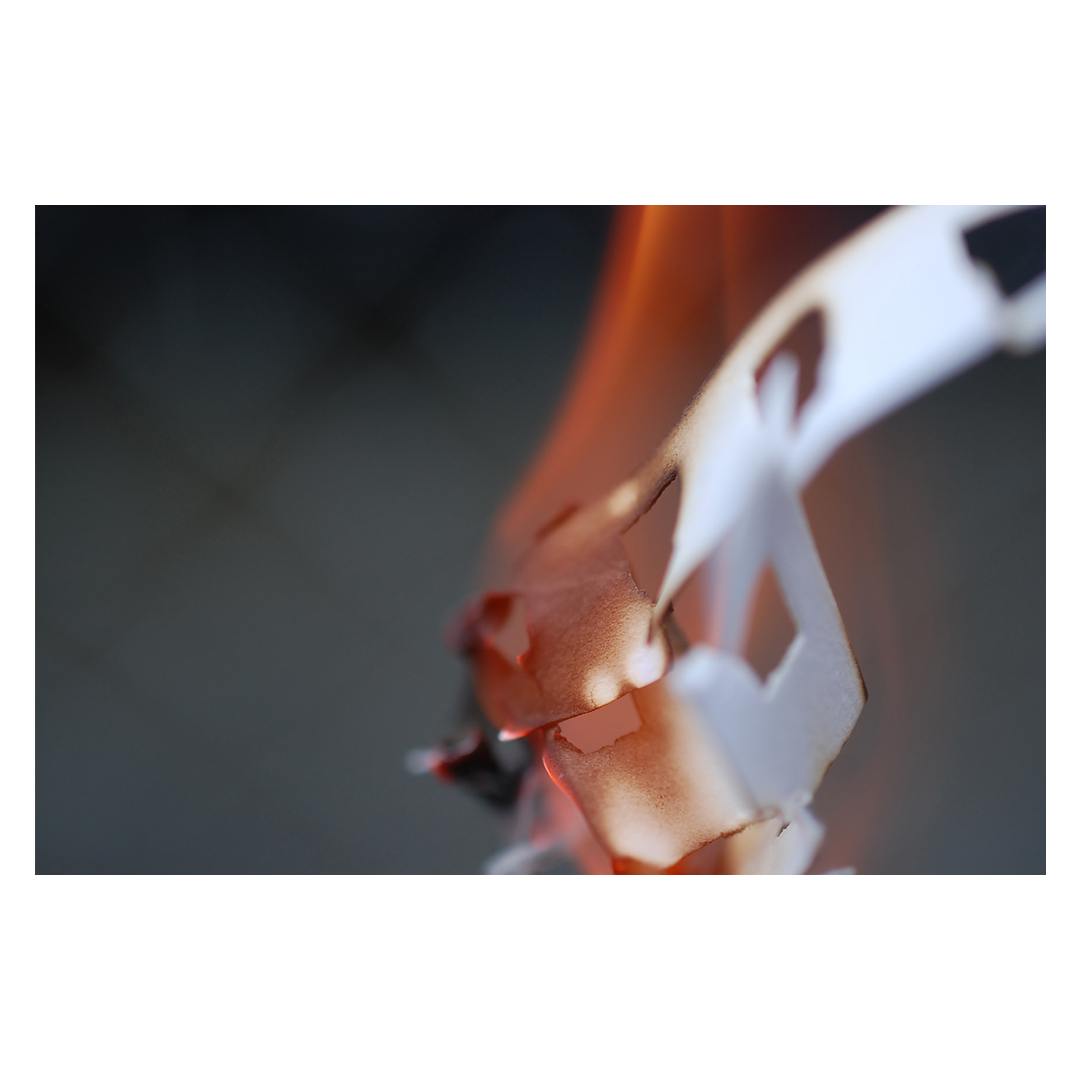
Ashkan Loghmani
Untitled
By taking this picture I want to show that even after cutting down millions of trees to make papers, people are still burning paper for various reasons—one of them being just for fun. Cutting down trees hurts the Earth drastically, exemplified by the wildfires in Australia.
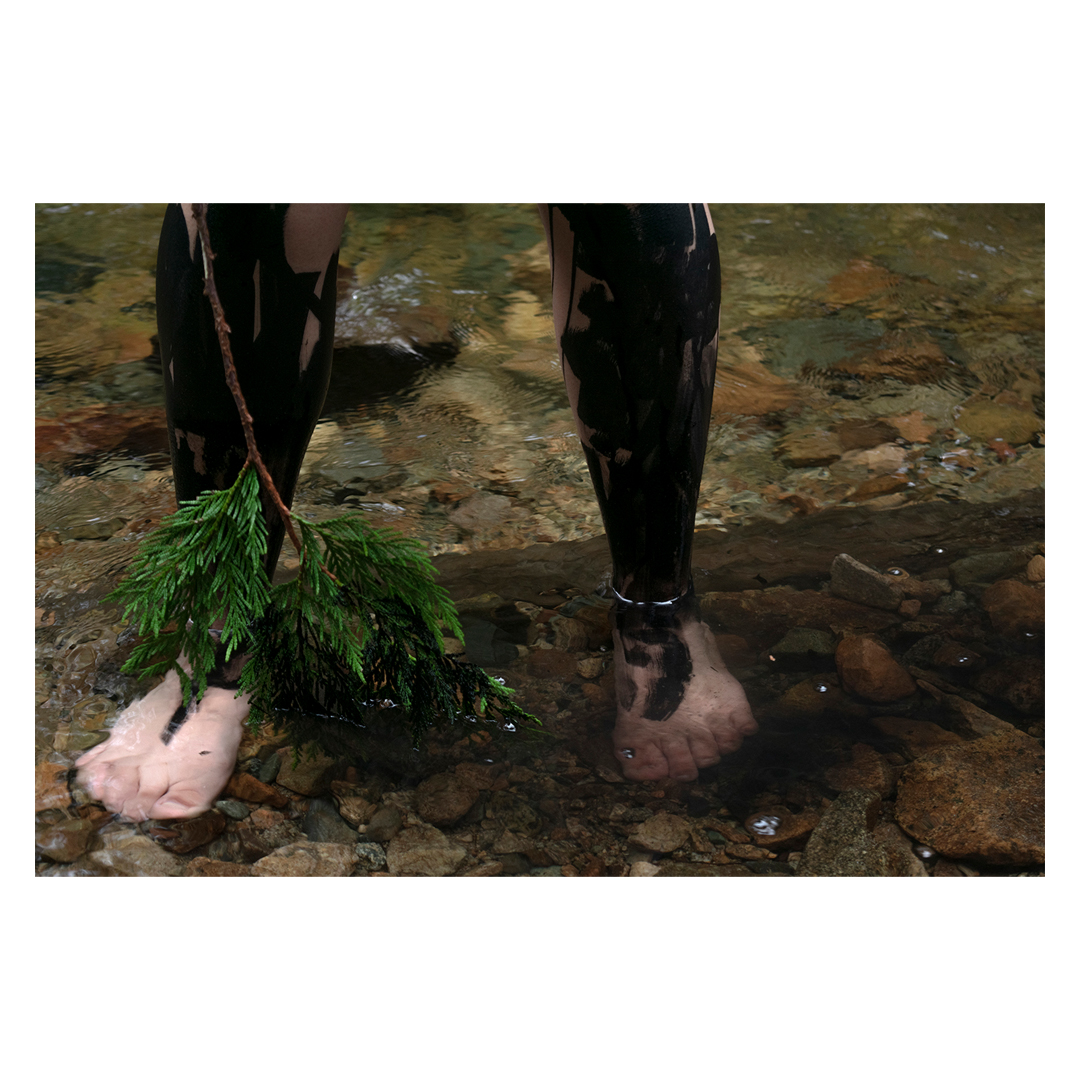
Lindsey Guerrero
Oil Cleansing
I chose to display the theme of “Global Warning” through the lens of Indigenous culture. In my photograph, Oil Cleansing, I stand in a stream to represent a common cleansing practice of the Squamish Nation called a spiritual bath. The practice involves bathing in a natural body of water and/or brushing oneself off with a cedar bow. The twist in this image is that my legs are covered in a layer of India ink to symbolise black oil. This photo brings awareness to not only water pollution, but also the many Indigenous land protectors who are fighting to protect our future from a worsening climate emergency.
Follow The Polygon on Instagram